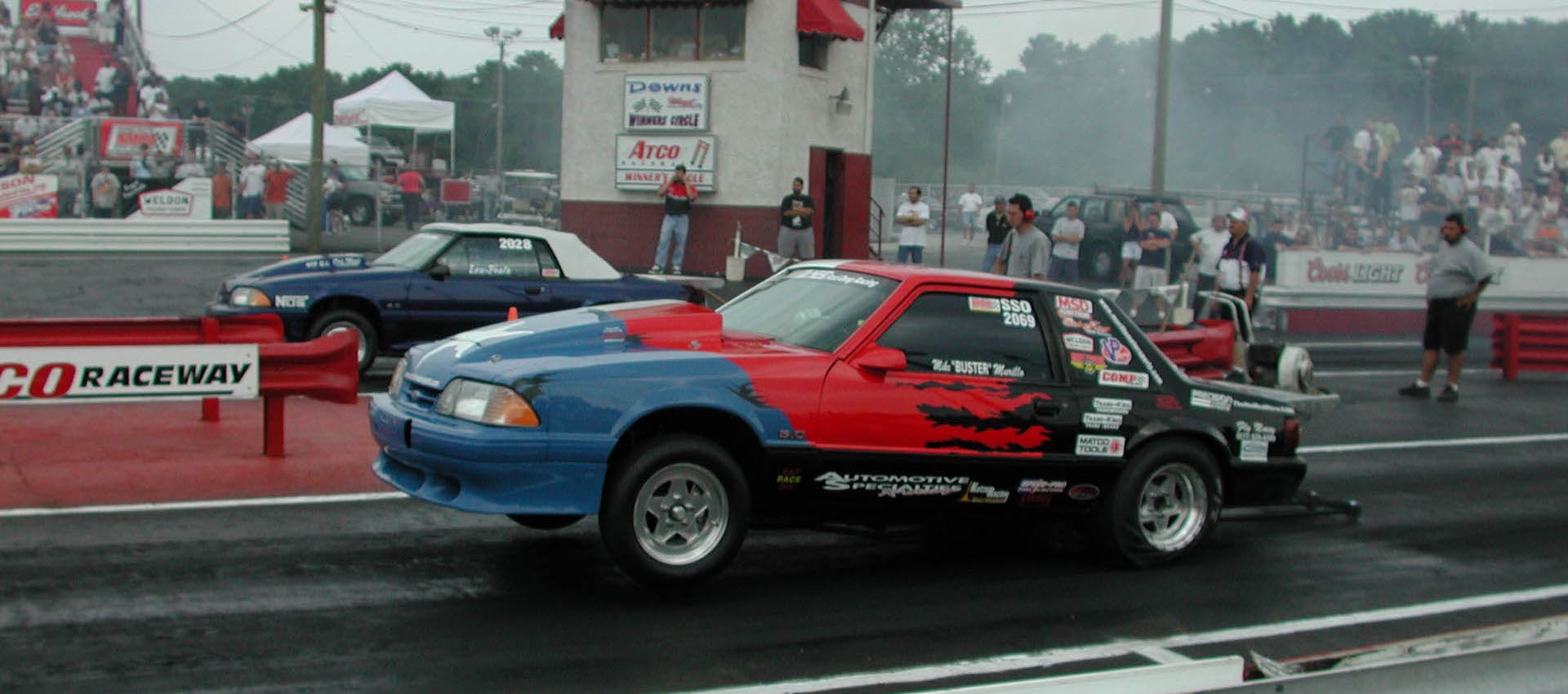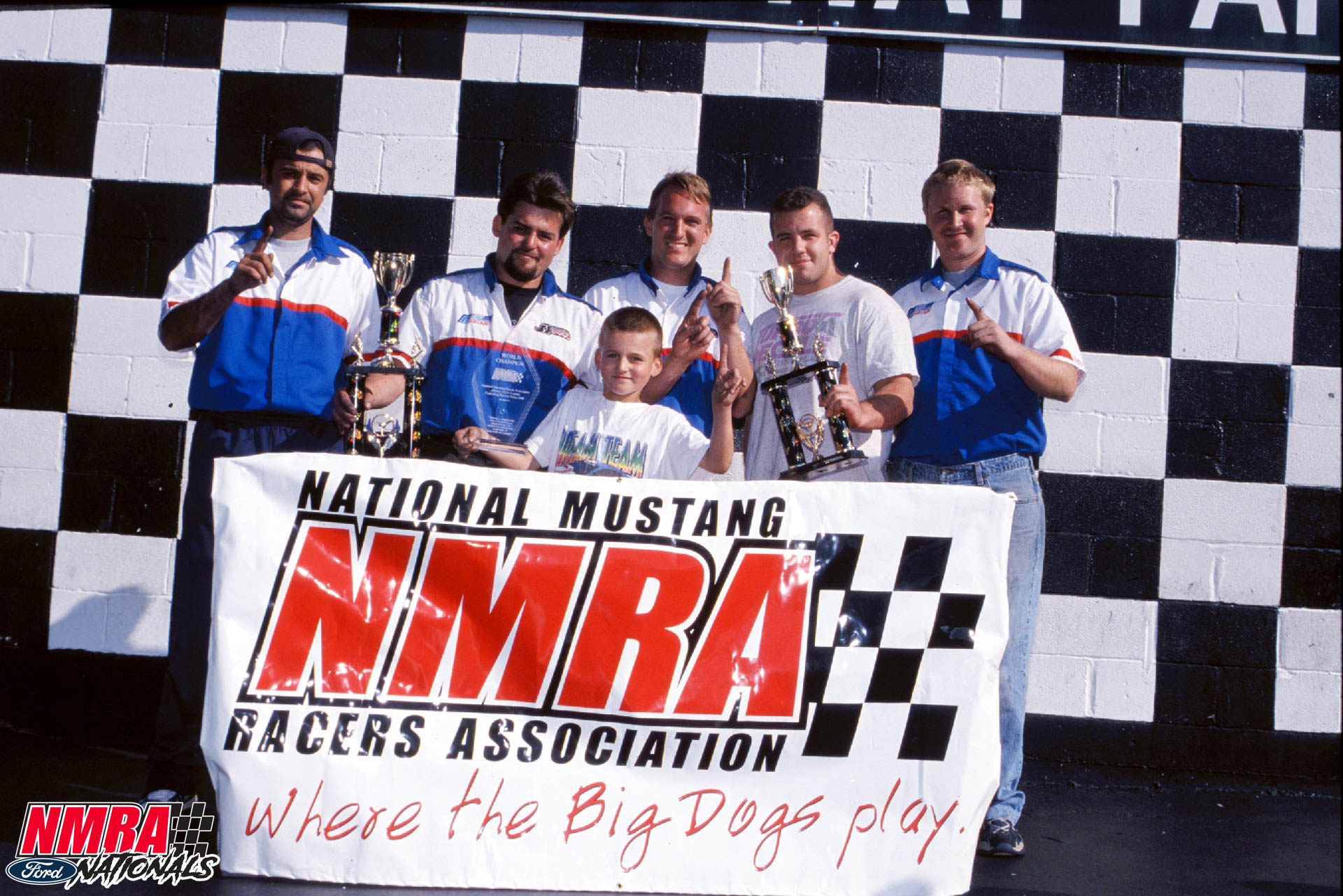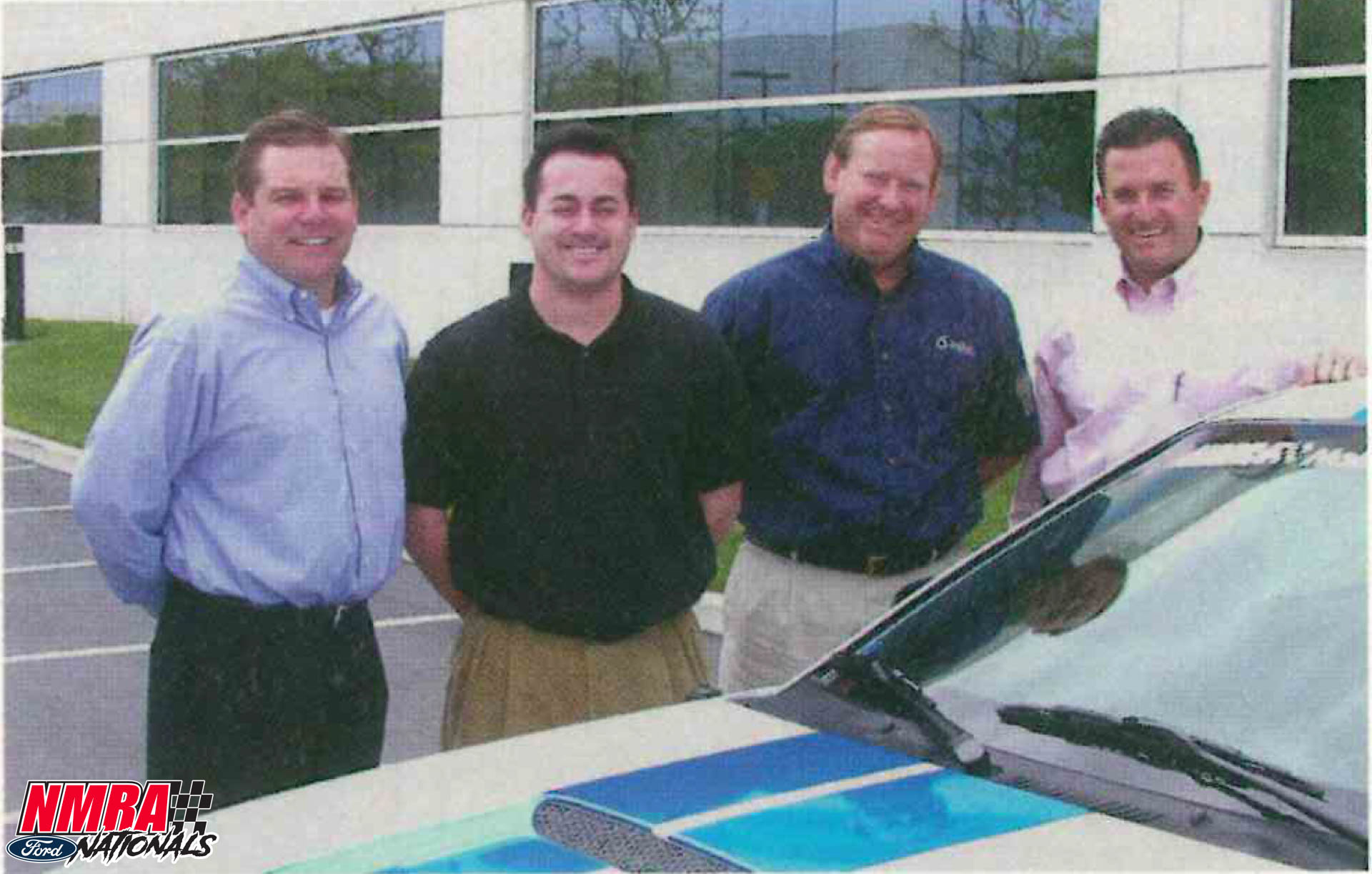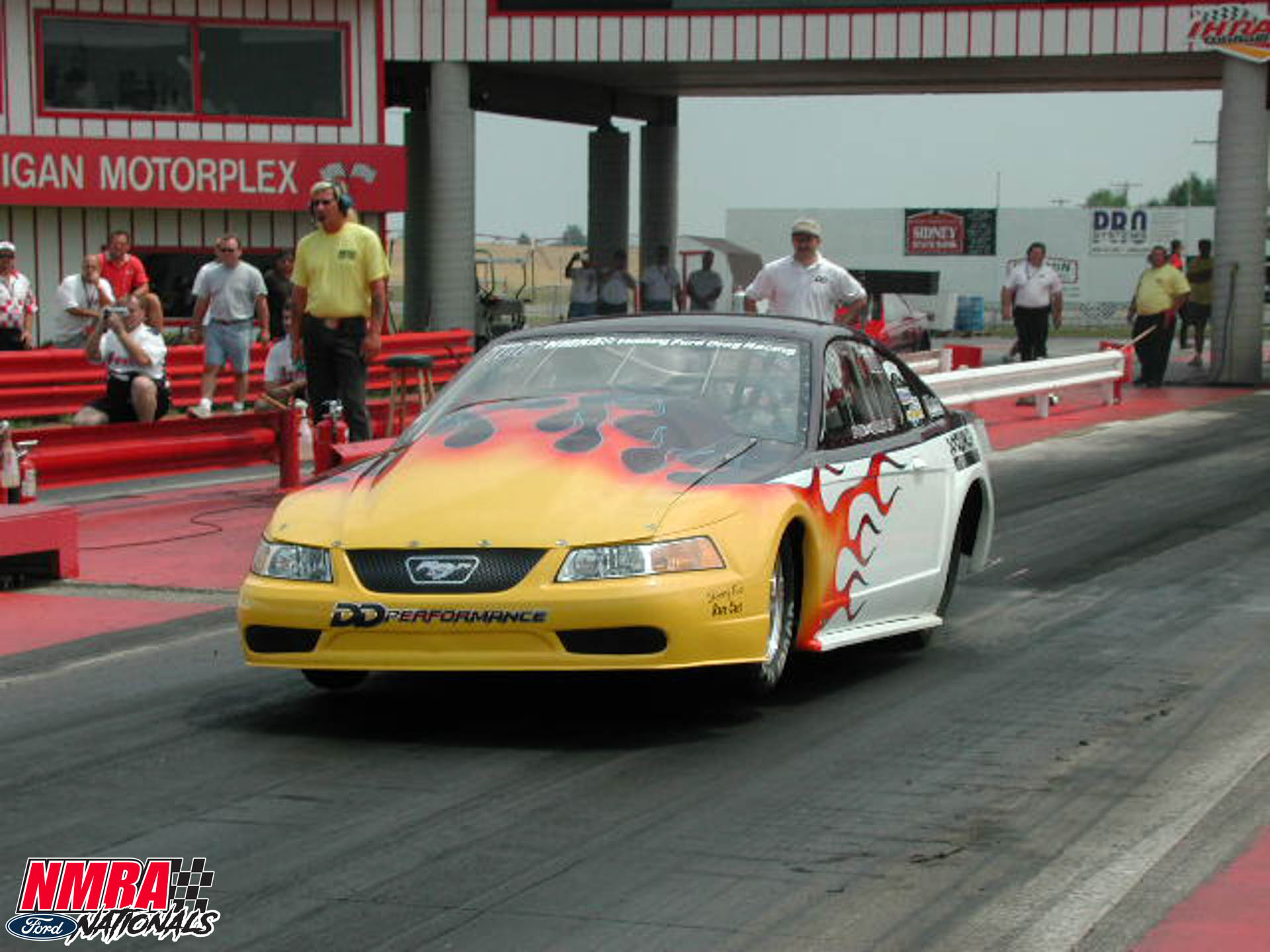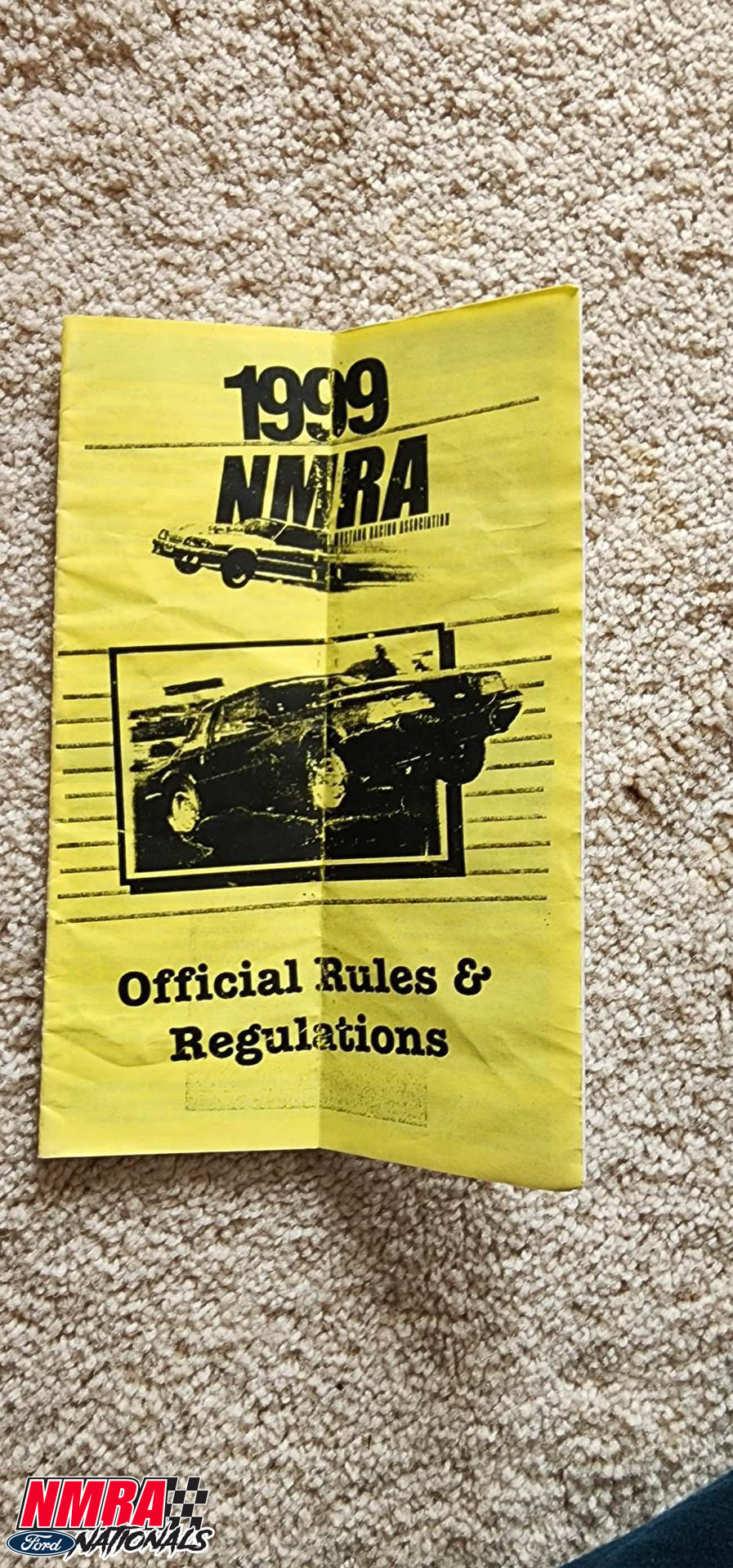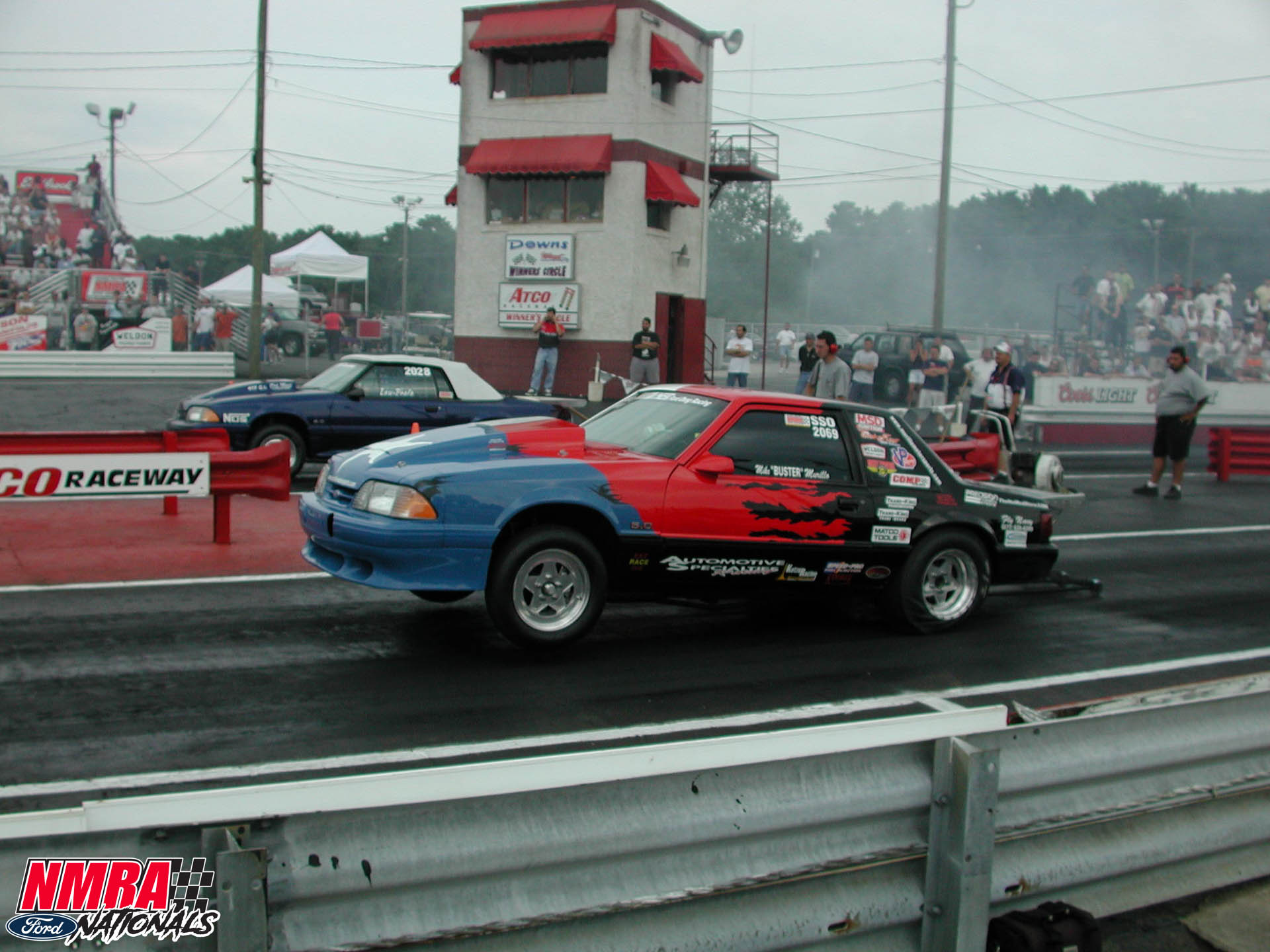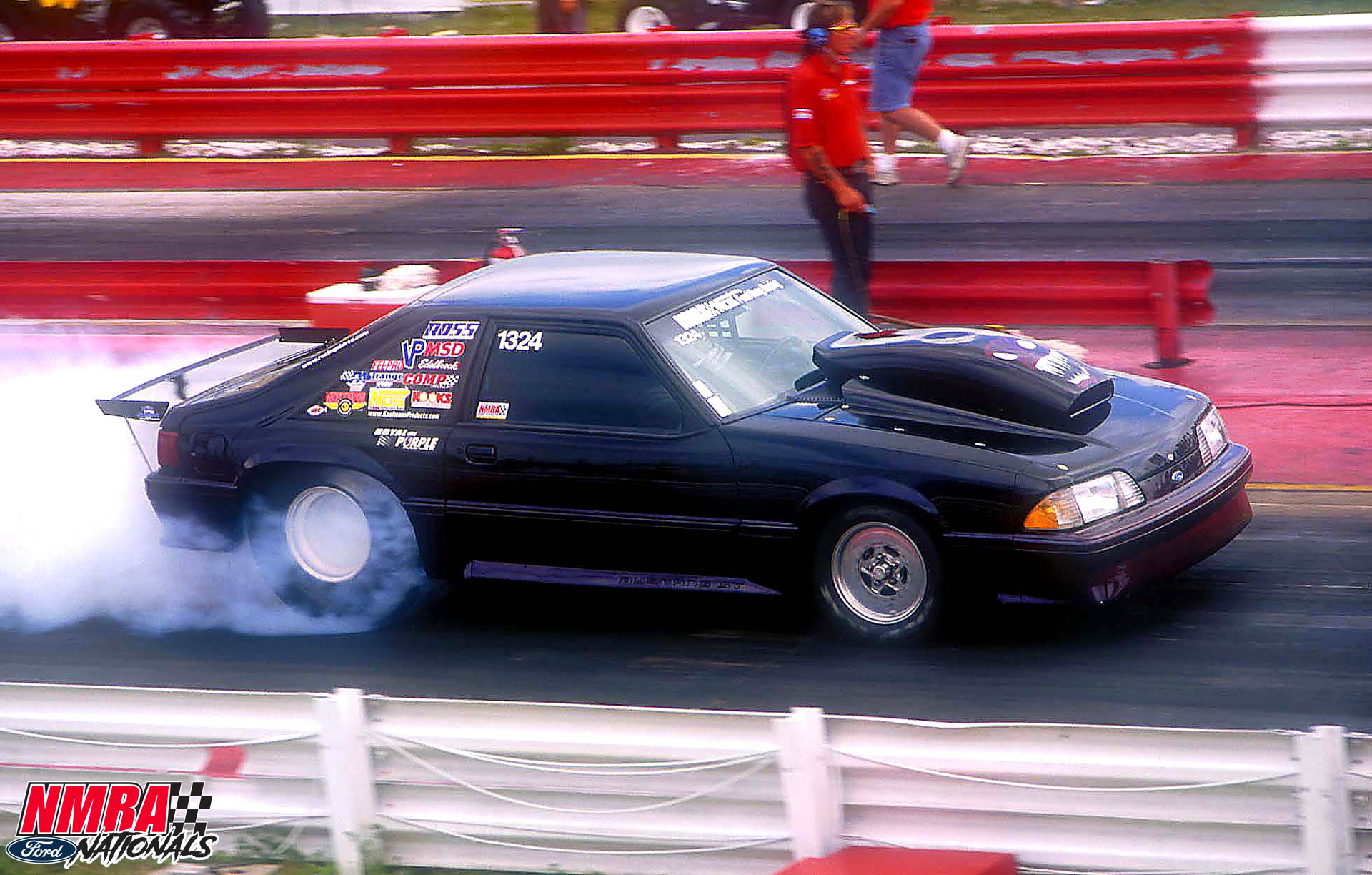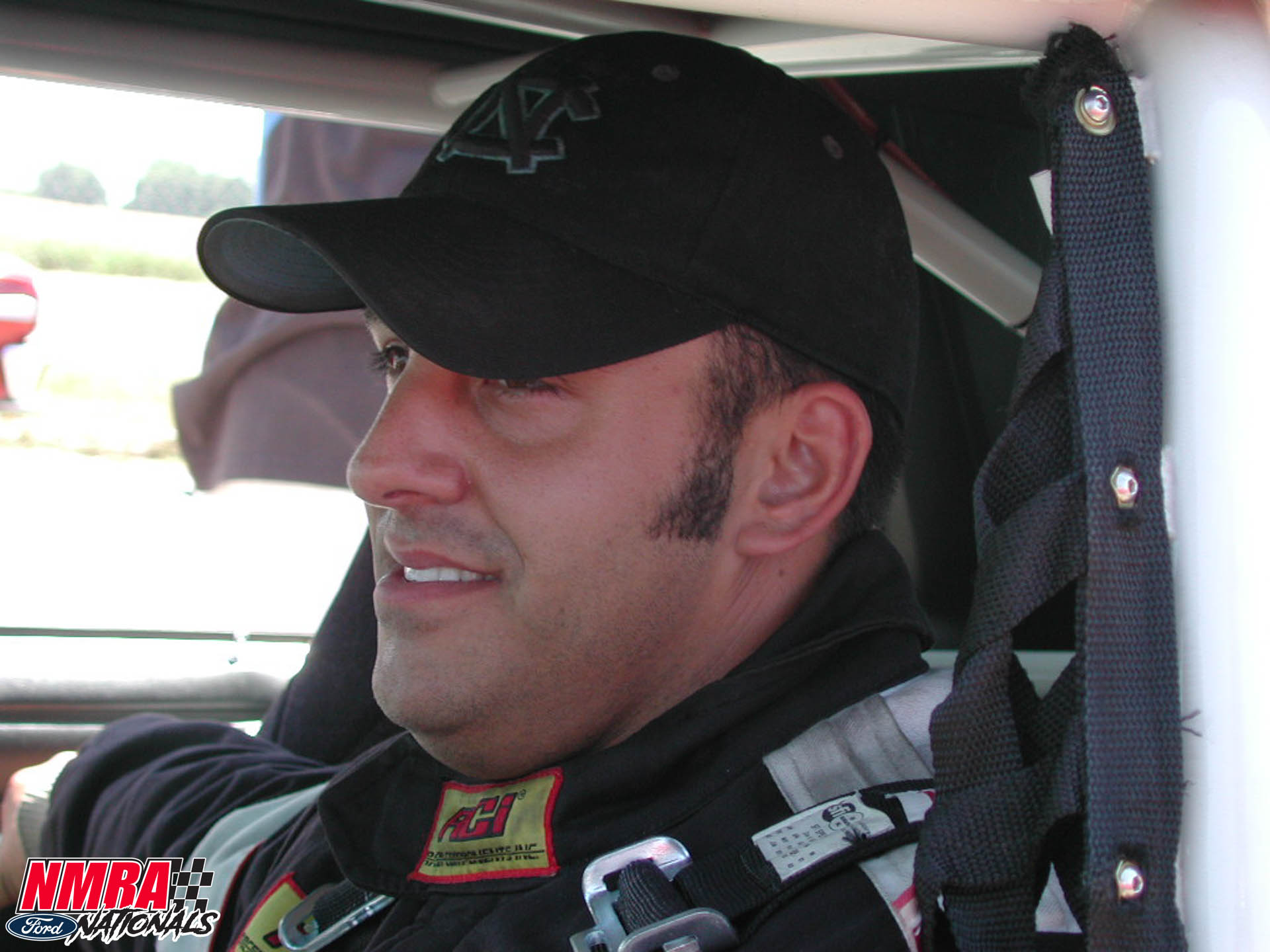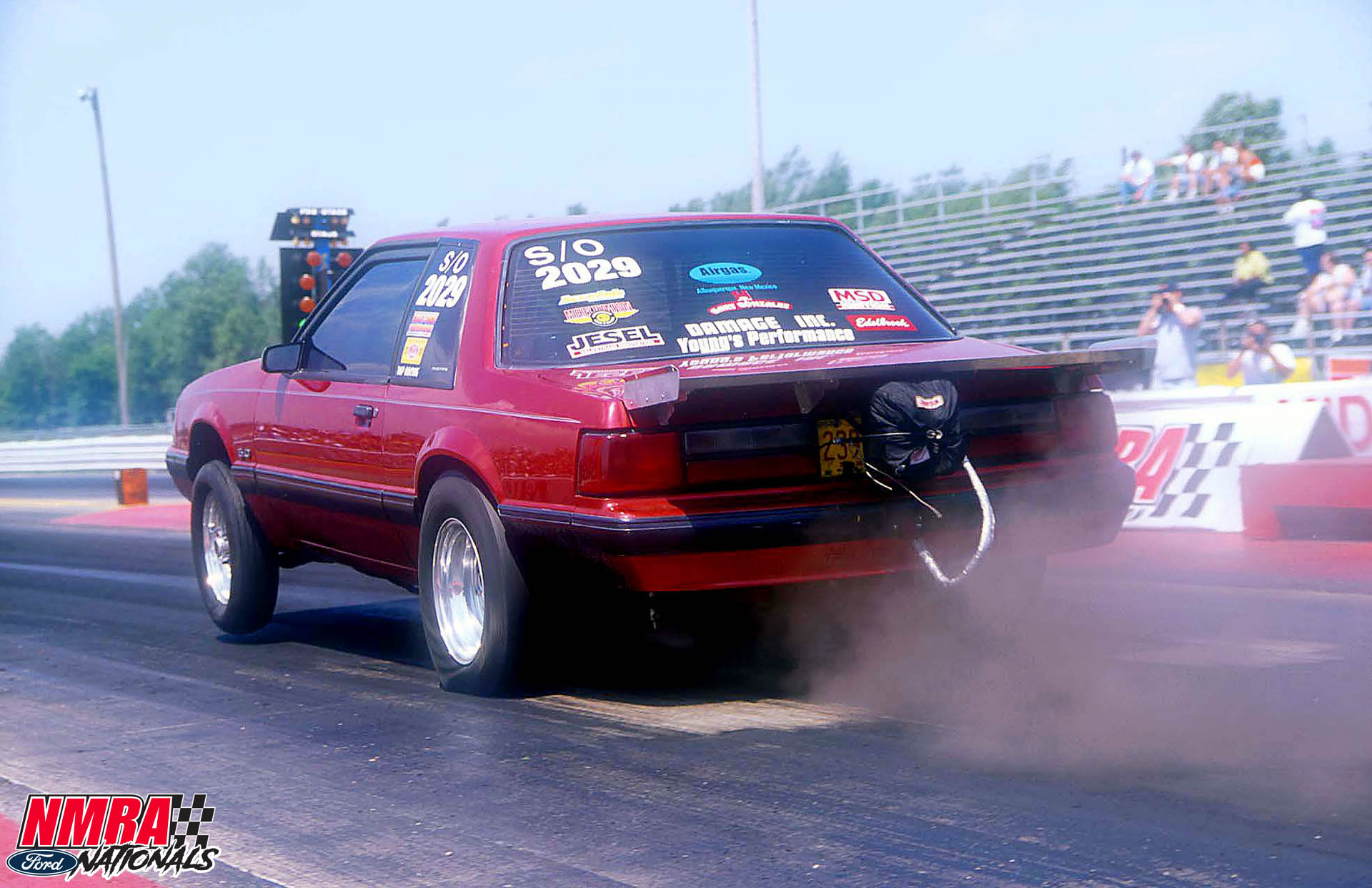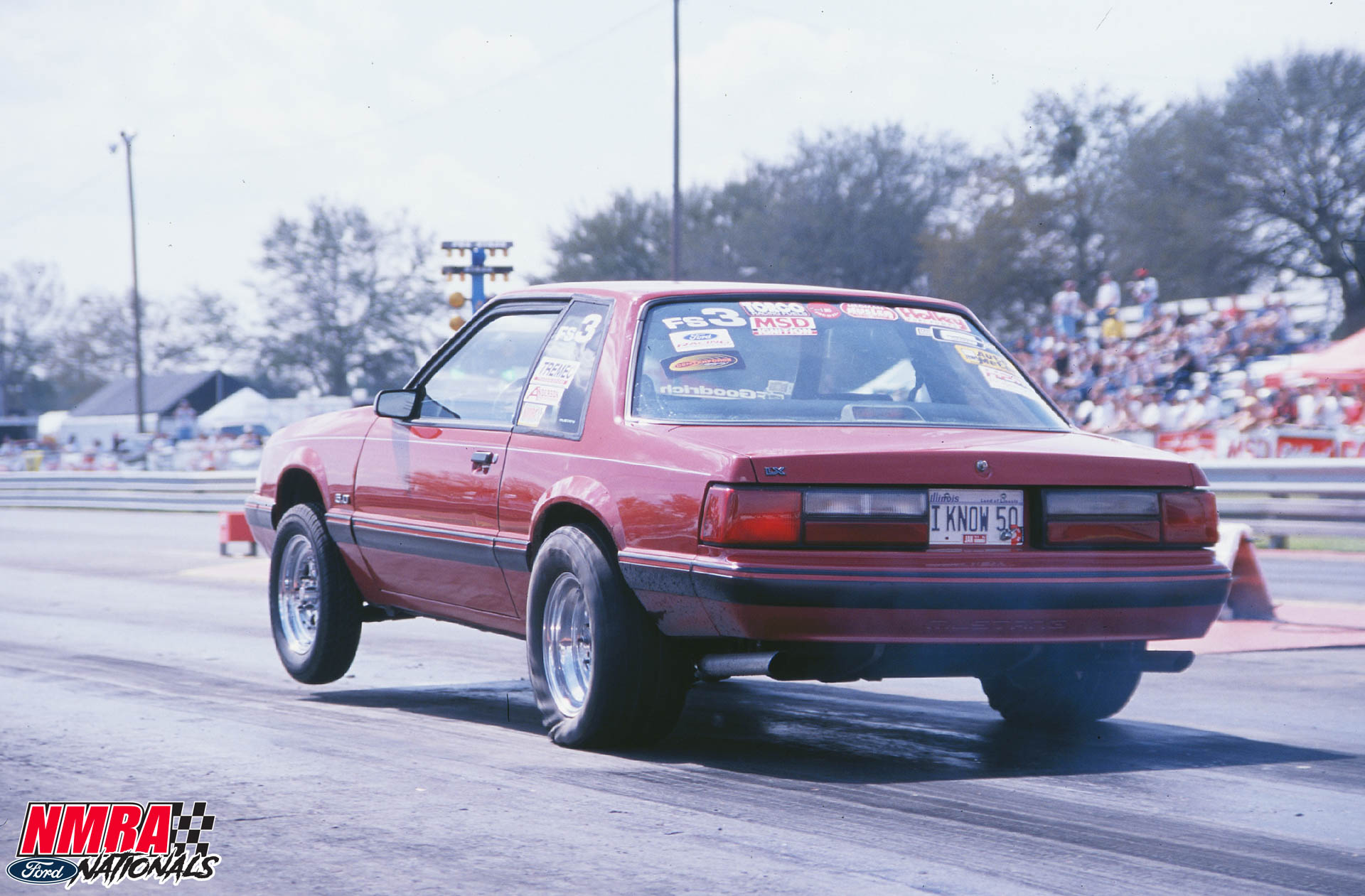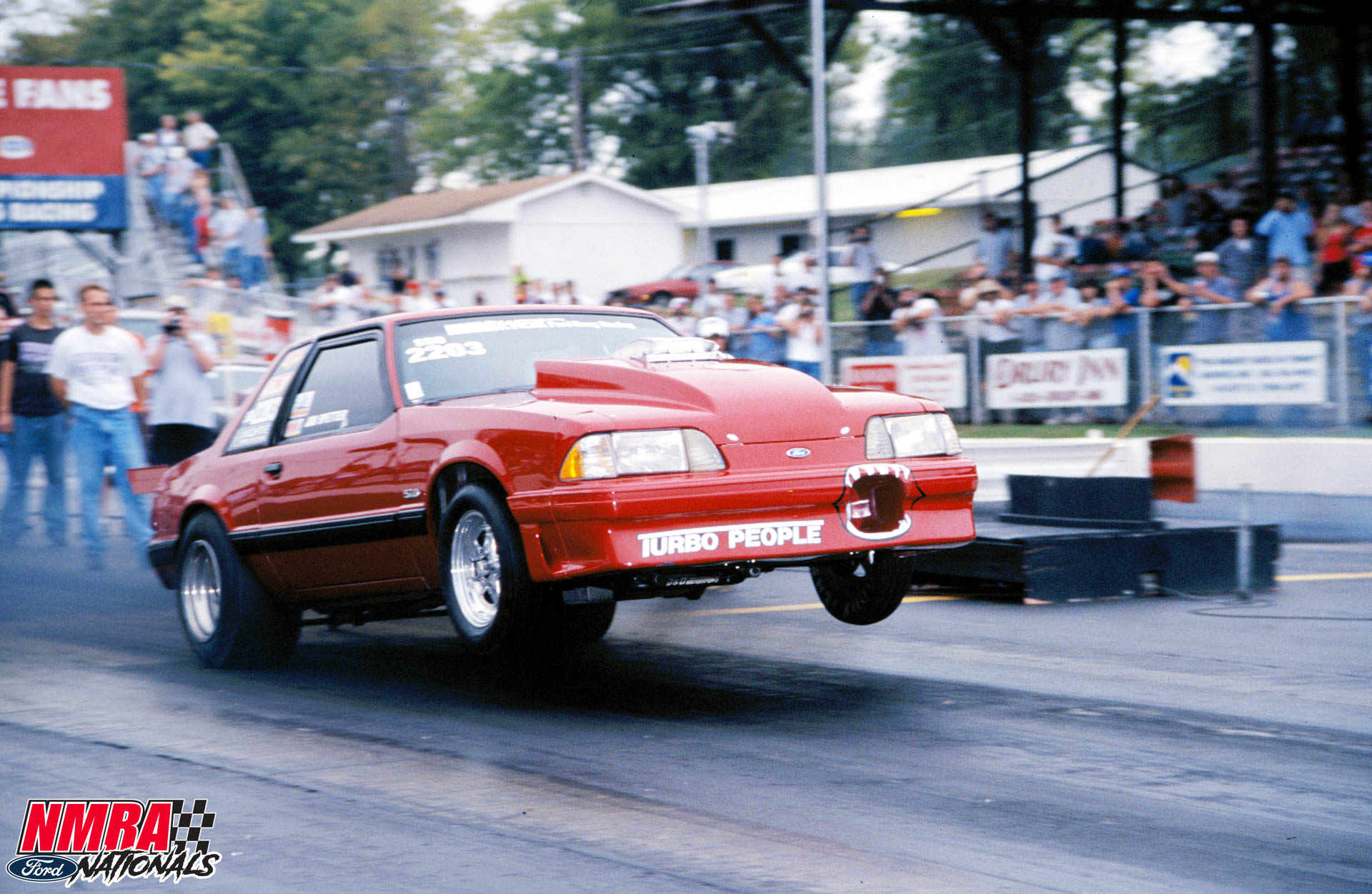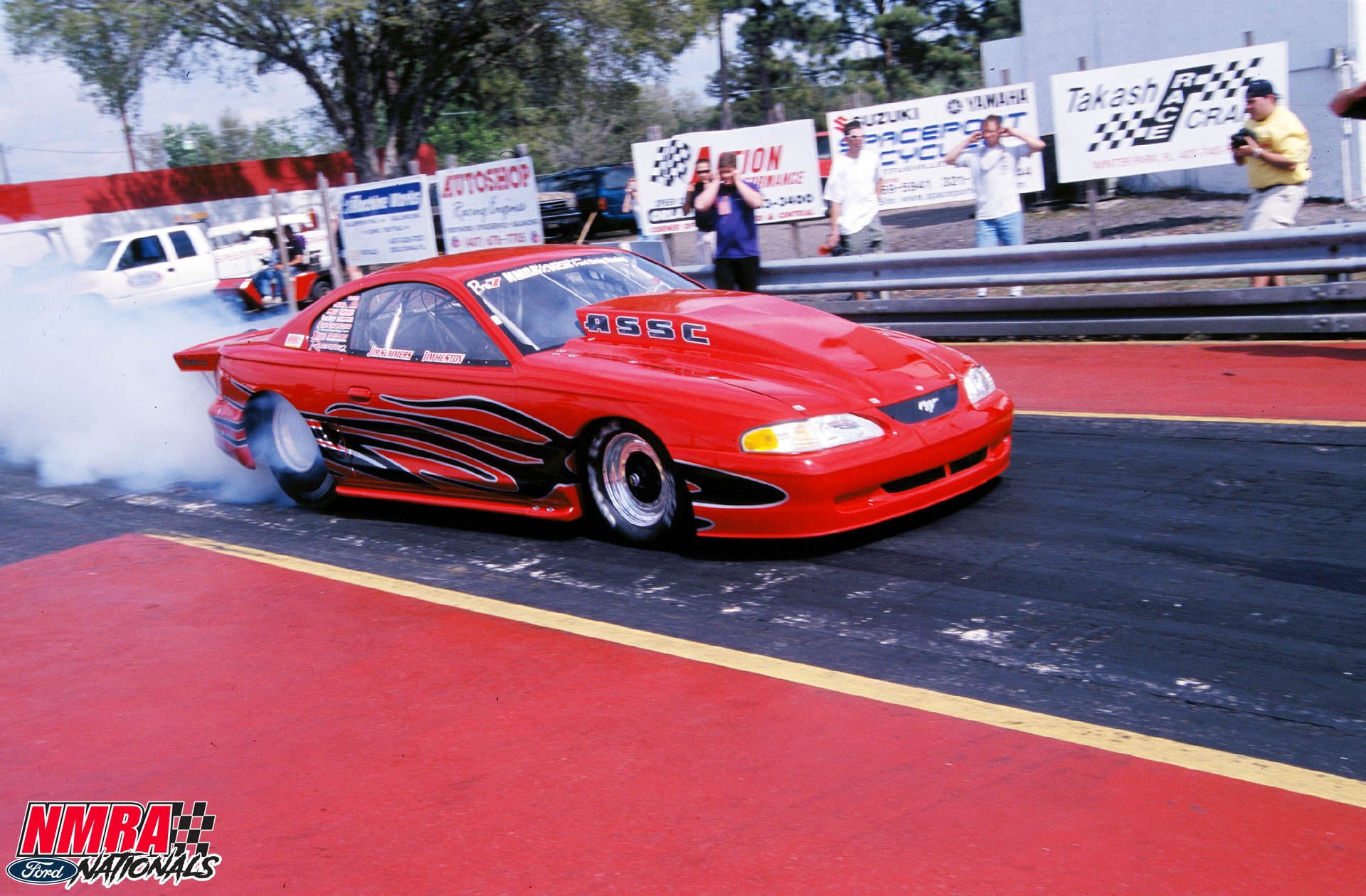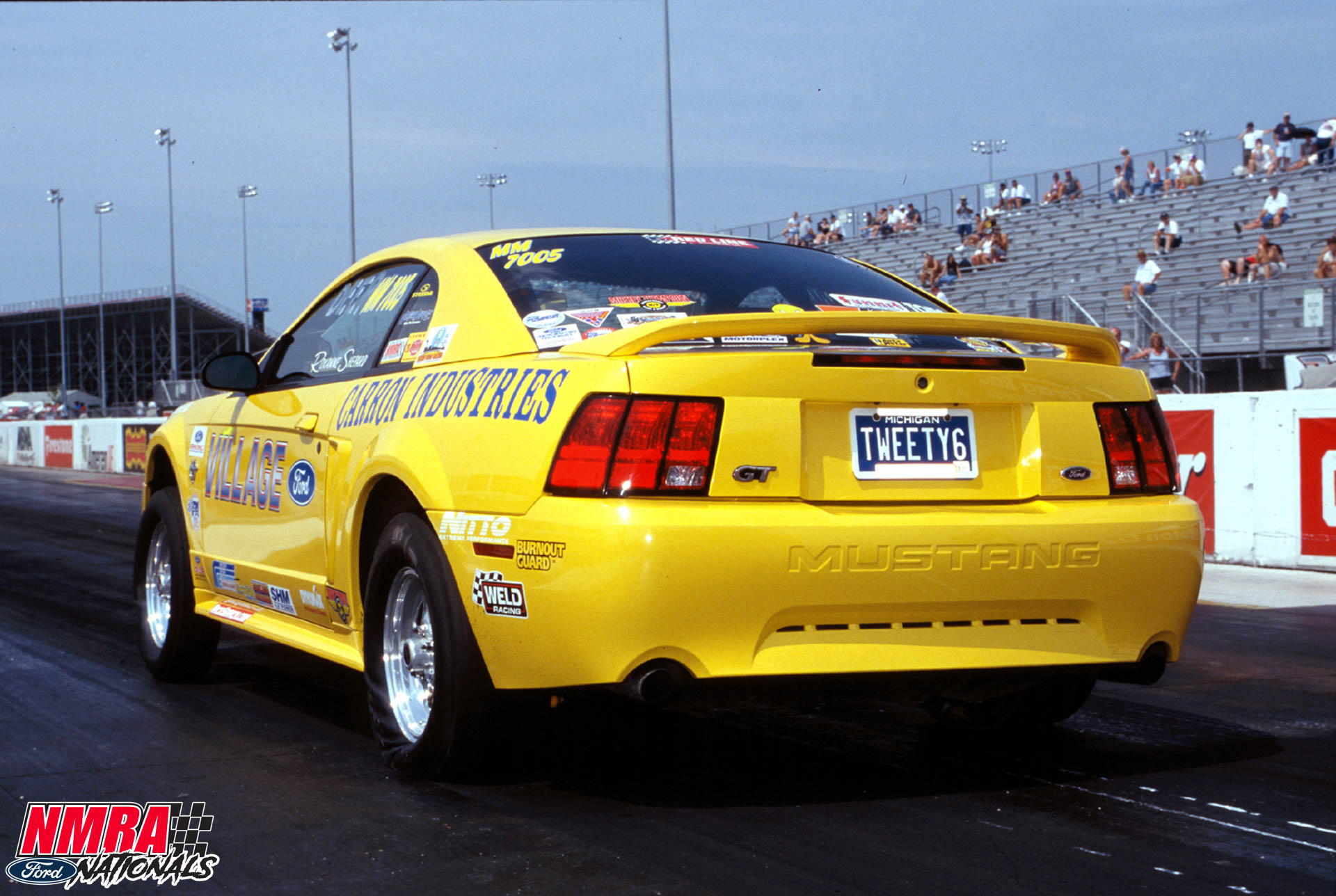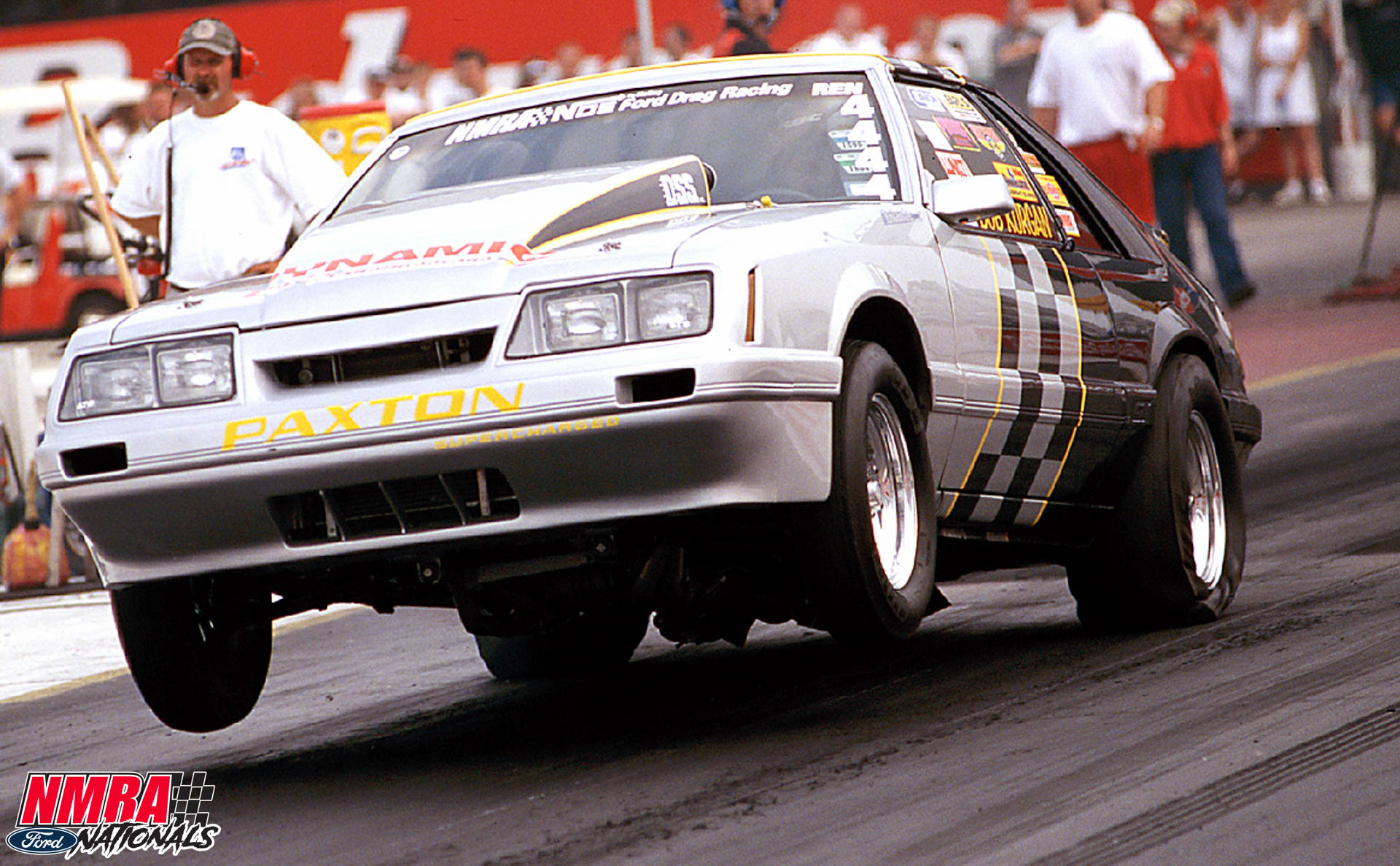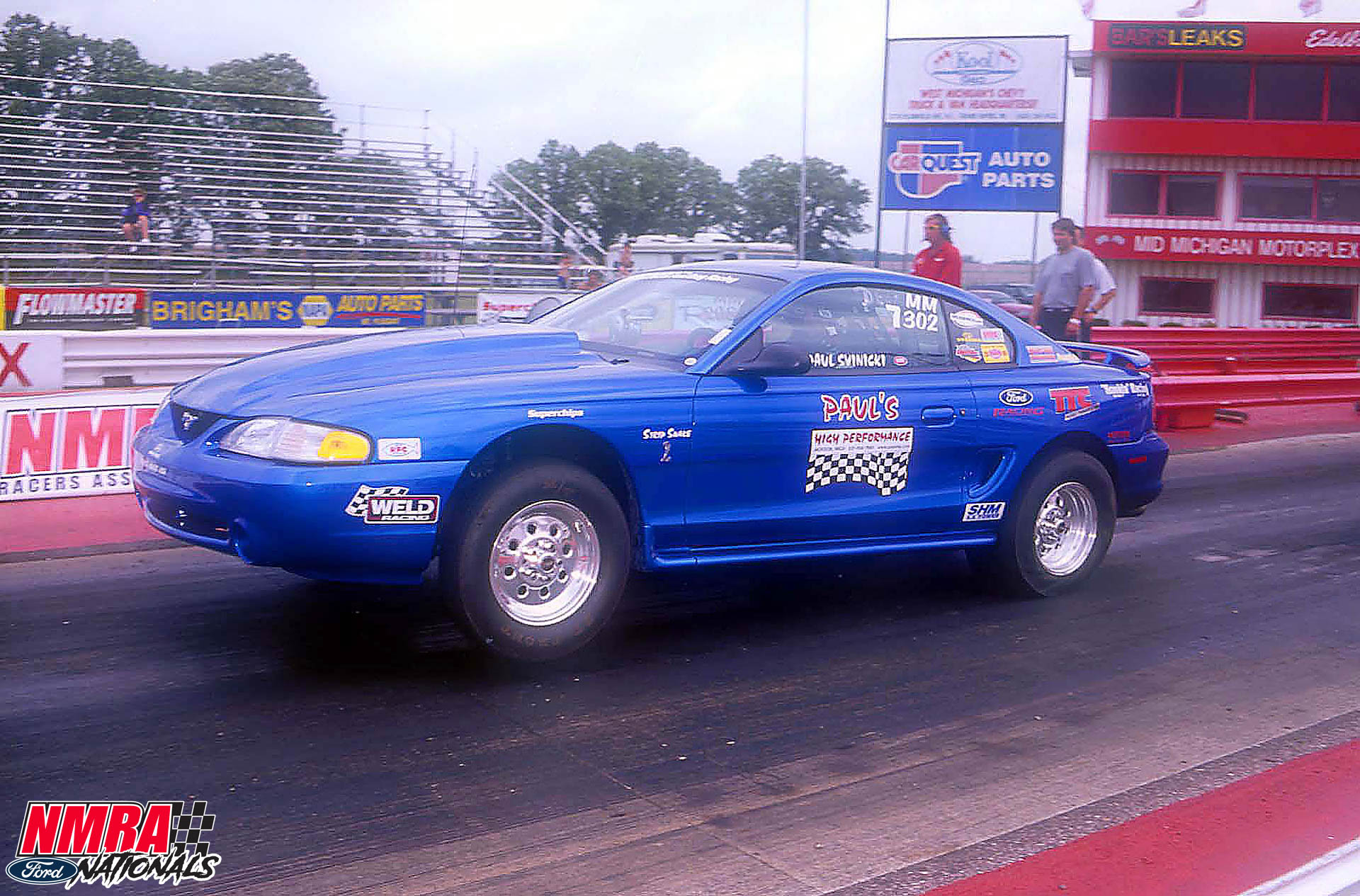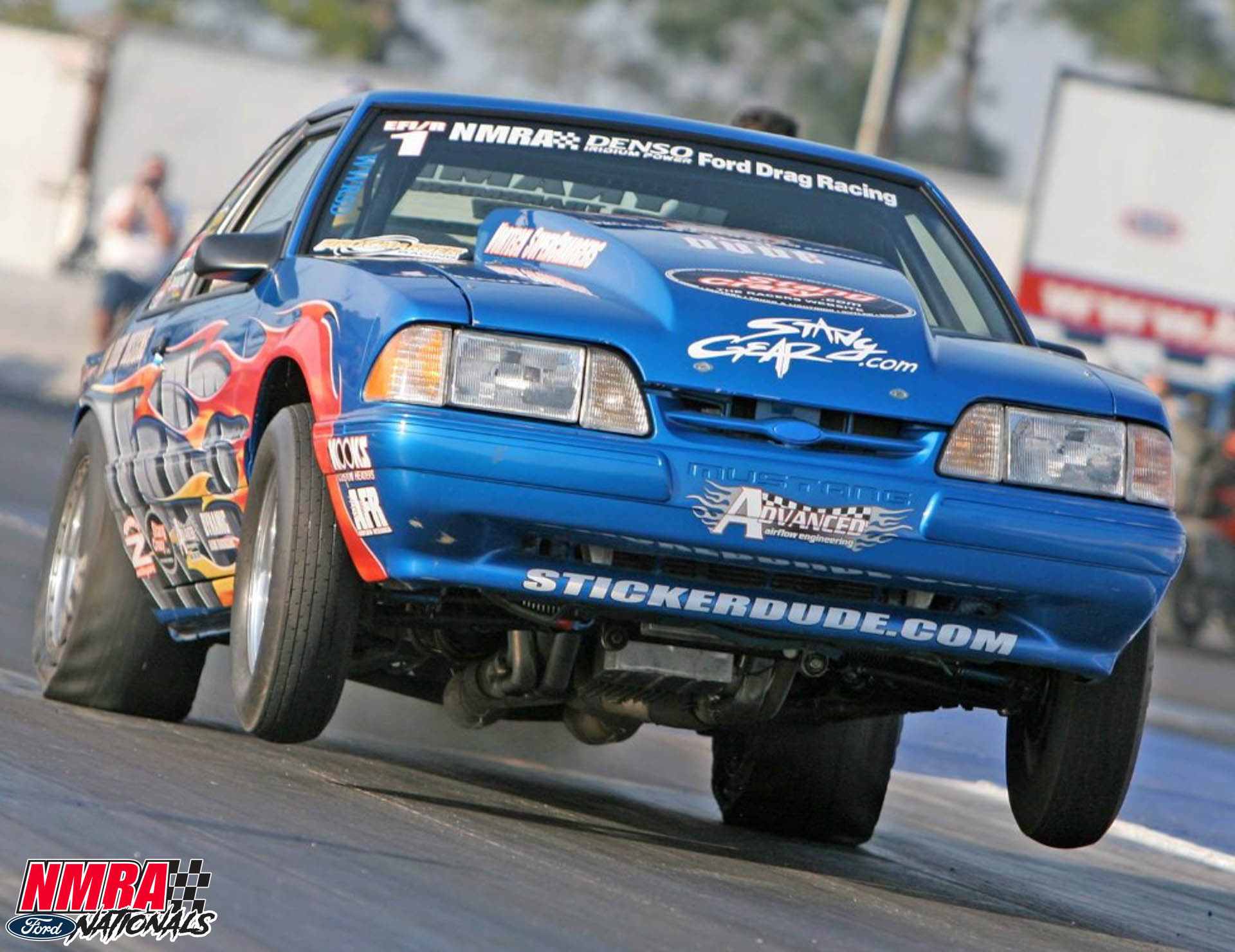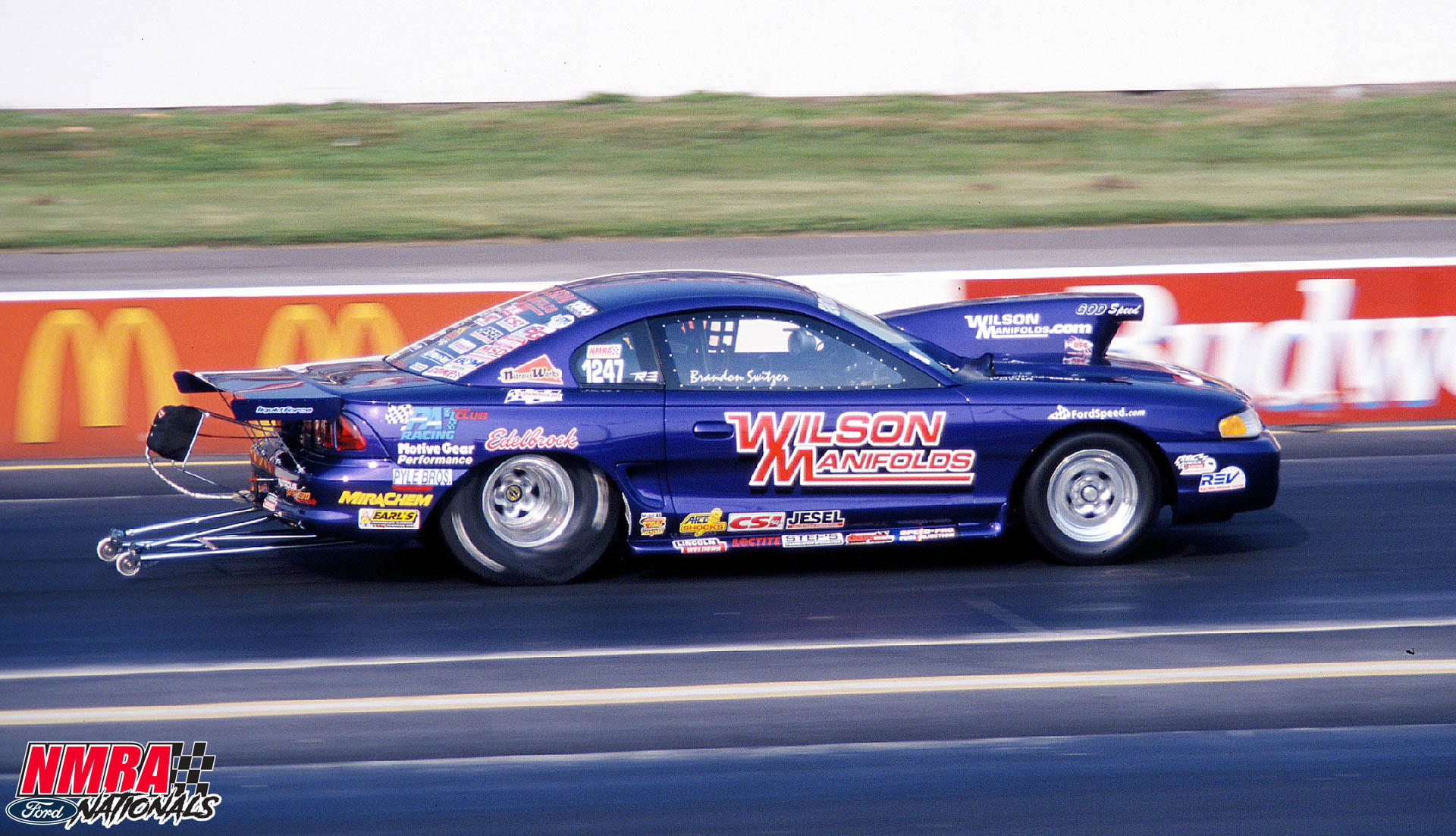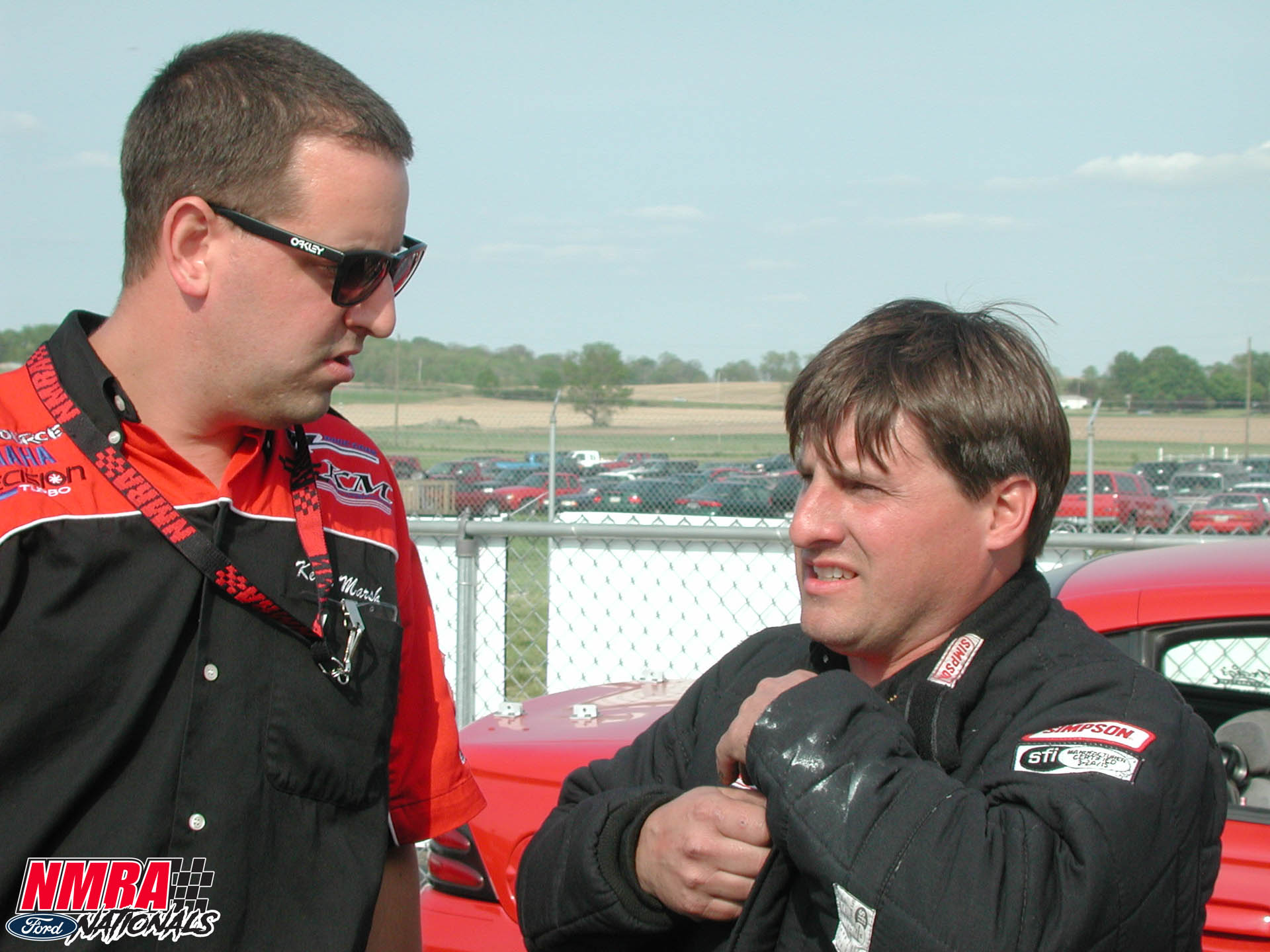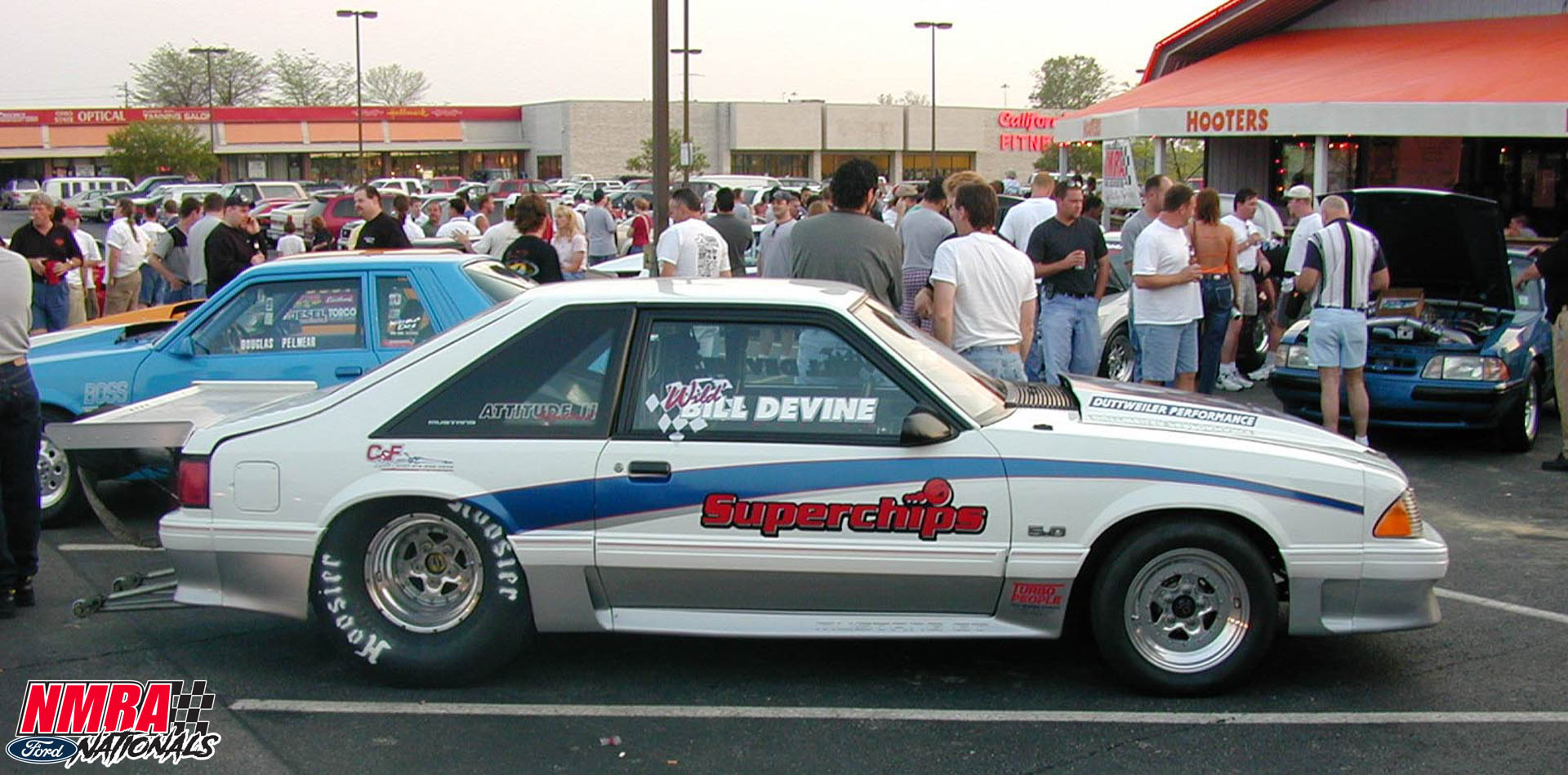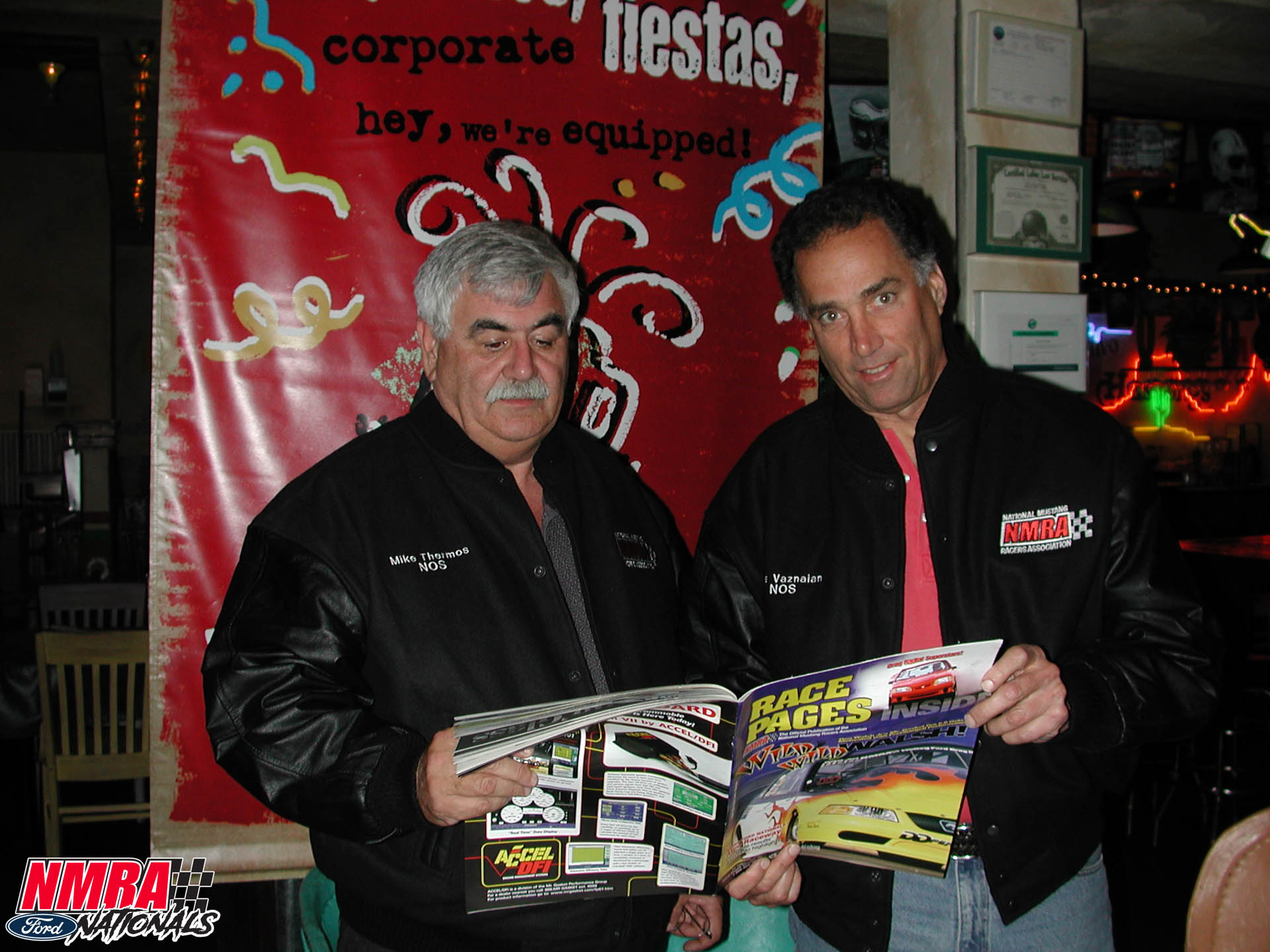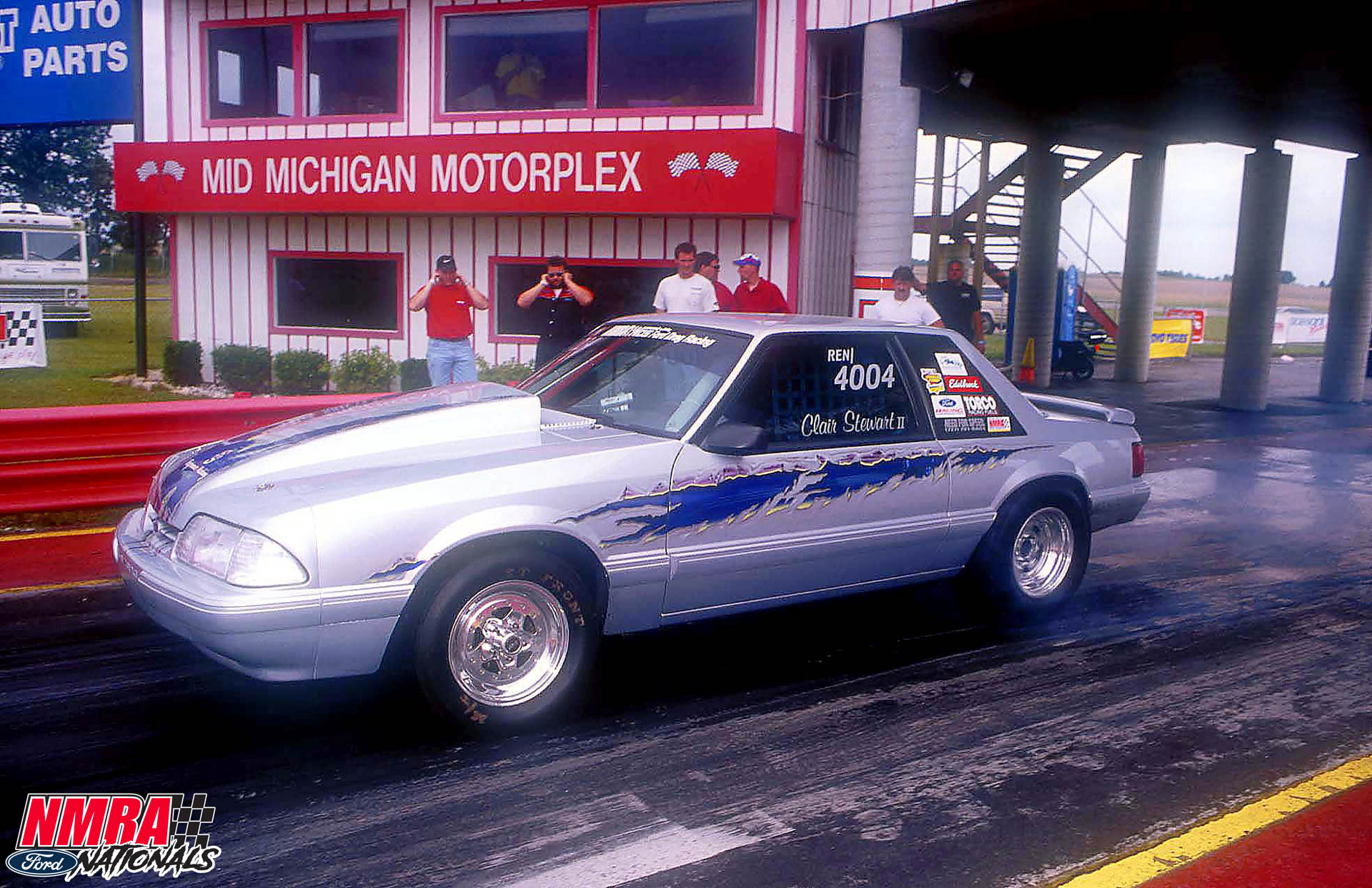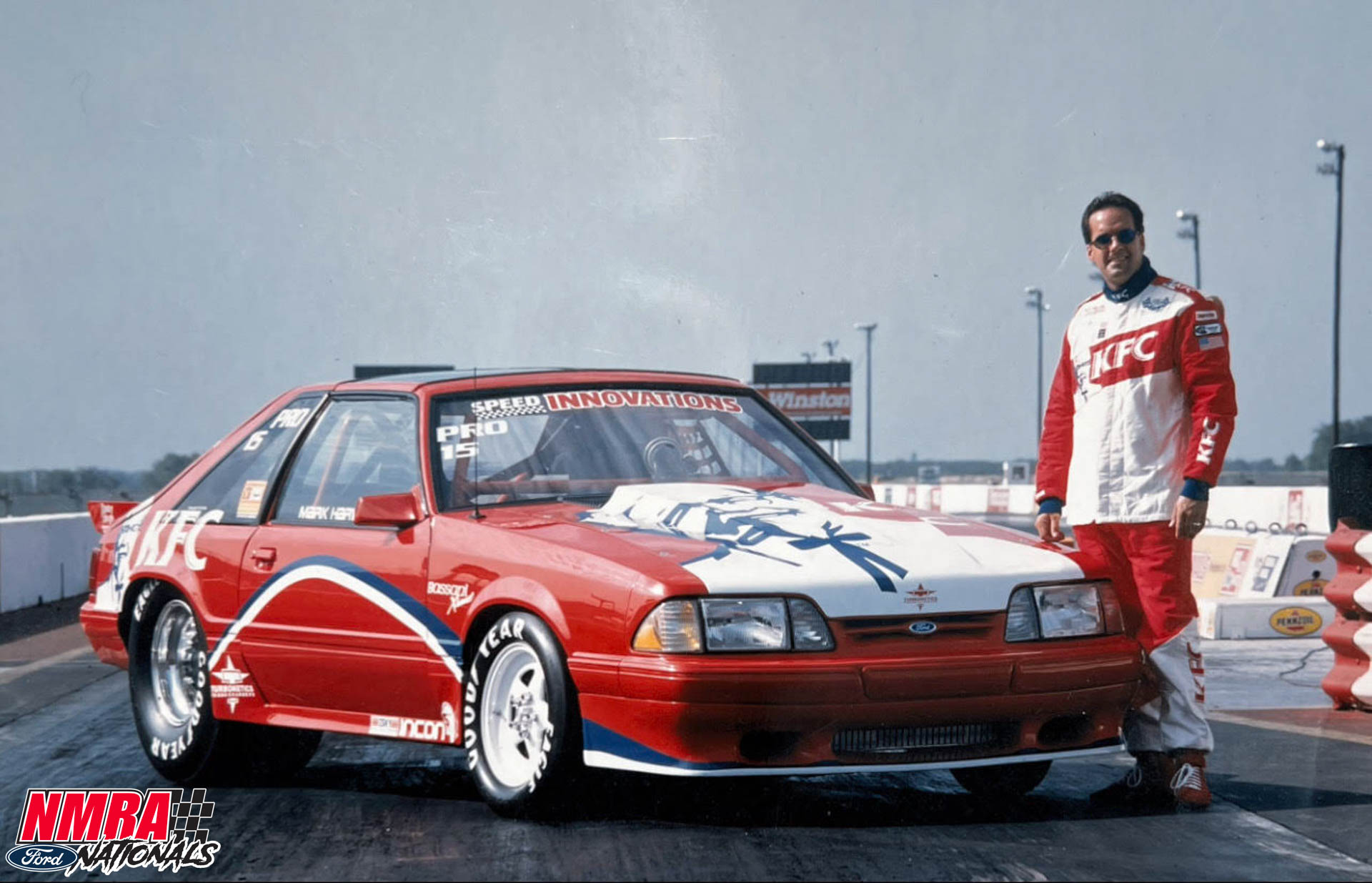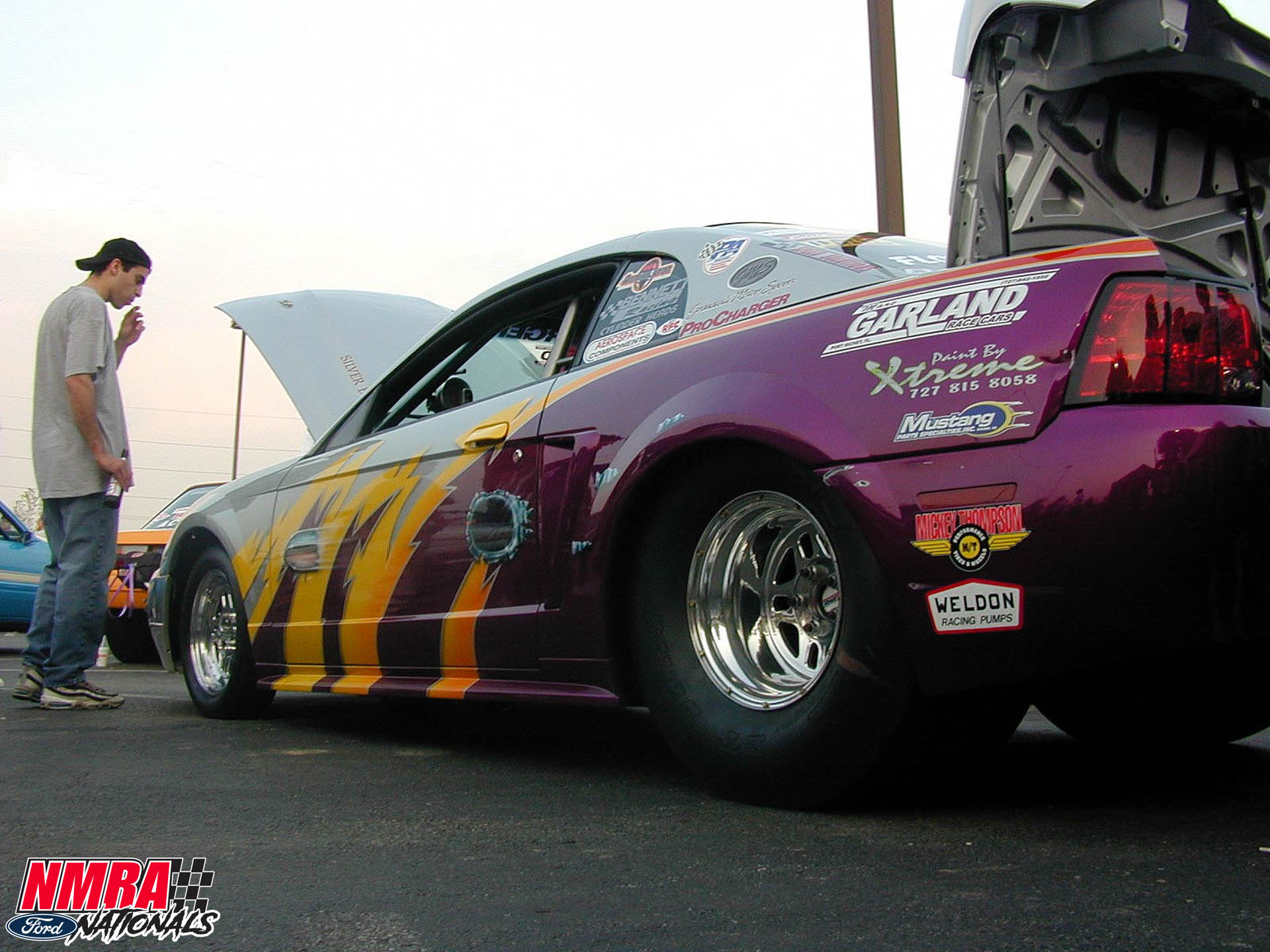Transforming from a Mustang club into a thriving Ford drag racing series, NMRA just sent it back in 1999
Written by Rob Kinnan
Photography by Paul Rosner and from the NMRA archives
A little more than two decades ago, National Muscle Car Association, the National Street Car Association, and Fun Ford Weekend, as well as a few other smaller sanctioning bodies, serviced street-based drag racers. The first two series catered to cars of all types, whereas Fun Ford, obviously, only opened up to Blue Oval machines. Back then, the 5.0 Mustang exploded in popularity with an enormous aftermarket presence and several magazines devoted to it. However, the only sanctioning body dedicated to the growing popularity of the Mustang was Fun Ford Weekend.
One of those magazines was 5.0 Mustang magazine, owned by Petersen Publishing and edited by Rob Kinnan, your humble scribe. The publisher was Steve Wolcott and my staff editor was a young but aggressive kid named James Lawrence. When Petersen bought Dobbs Publishing in Florida and gave me the option to either look for a new job or move to Florida to be a part of their “Ford books,” which included Super Ford and Mustang Monthly (Petersen also owned Mustang & Fords which was set to move as well), I made the move while Steve and James remained behind and held down the California branch.
During my absence from the Wilshire Boulevard office, Steve and James hung out often, usually going to lunch at Baja Fresh down the street in Beverly Hills. The conversations always went to both of their passions, which were business and cars. They came up with the idea of a membership club for late-model Mustang owners, which didn’t exist at the time. The proposed club would offer members discount coupons, shirts, license plate frames, and even a magazine. Steve was relatively new to the Mustang world, but James had promoted a Mustang race at Carlsbad Raceway a little south of Los Angeles and had run a business named Ford Performance Solutions that sold custom Ford engines and speed parts, so he knew the market well.
Not known to most, Steve and James’ first business plan together was an affinity club for pets (which I heard about in excruciating detail in a hotel room we shared one night at the Fun Ford Finals in Dallas when James refused to stop talking about it, regardless of how late it was and my constant threats to fire him if he didn’t shut the hell up!), but they ultimately decided on a club for something they really knew: late-model Mustangs and racing. During this time, Mustang heads-up drag racing was just getting started, and we all were paying attention.
“Attending the Spring Break Shootout, Civil War Shootout and World Ford Challenge events in ’98 created much discussion between me and James (Lawrence) about the need for a late-model Mustang association with benefits and special events members could attend,” said Steve Wolcott, Co-Founder of NMRA. “Our publishing background could develop Race Pages, our relationships would bring advertisers and sponsors, and James’ one Southern California race gave us the confidence that we could execute events.”
So that was the birth of the NMRA, National Mustang Racers Association (not to be confused with the National Model Railroad Association, also NMRA). This was late 1998, and promoter George Gonzalez had just held the massive and popular World Ford Challenge in Bowling Green, Kentucky.
When word got out that WFC might relocate to Route 66 Raceway in Joliet, Illinois, it created a vacuum in Bowling Green, so the guys began thinking of filling that vacuum by holding the Battle at Bowling Green, to be followed by Fords at Firebird (in Arizona). The word got out, no doubt helped by a story that yours truly ran in 5.0 Mustang, 100 percent written by James, on the goals and benefits of the NMRA, announcing to the world what was coming.
As longtime friend and contributor (now Hot Rod magazine’s Network Director) Mike Galimi said, “By 1998 World Ford Challenge was created, bringing the attention and money into the Mustang ranks and it was the start of something big. The market was so red-hot it wanted much more than a once-a-year get-together. Fun Ford saw growth and Steve Wolcott and James Lawrence went even further with the creation of NMRA.”
“I always point out that the 5.0 Mustang scene was the right place, right time sort of situation, not just NMRA, but the entire movement. If you were to look at the demographic at the time, most racers were old enough to go on these adventures, forgo sleep required to go racing all the time, and the cost to get involved was still affordable and, in many cases, the Mustangs were home-built in the early days,” Galimi added. “There was Fun Ford Weekend and it had heads-up categories, but it wasn't until Muscle Mustangs & Fast Fords got involved that the Pro 5.0 and small-tire scene got the attention it needed to light the spark of excitement across the country.”
That made the phone ring in Los Angeles, and it was George Case from Maple Grove Raceway in Pennsylvania. He said that the Stormin’ Norman Invitational, which they had held the Ford Motorsport Nationals for years, was falling off and Case offered NMRA partnership on the race. Steve and James took the bait and began a contract with Case and Maple Grove.
At that point that NMRA was indeed born. The world knew it and the news began attracting some big-name racers, including Billy Glidden, son of the most famous NHRA Pro Stock racer in history, multi-time champion and drag racing hero, Bob Glidden. Billy was just one of the big names, as a bunch of them began showing interest in the brand new NMRA, rivalries began among racers, and suddenly the NMRA had legitimacy.
That first race at Maple Grove featured Pro 5.0 as the big-tire class, with support from Street Outlaw (10.5 tires) and a few others. That race was also where they came after me in earnest to run the print magazine. I saw their potential, so after some late-night negotiations with James, I drove my ’87 Mustang LX coupe back to Los Angeles and set up a desk in their “lavish” Fountain Valley office. In reality, it was a tiny warehouse with no heat and four desks — one each for Steve, James, myself, and Remy Ito, who we recruited from NOS. There was also a small “office” in front that held Steve’s wife Amy and their new baby boy Jack.
Speaking of NOS, they were our first supporters and sponsors. Dale Vaznaian and Mike Thermos were huge supporters of the early NMRA, signing on as the title sponsor before they sold the company to Holley. Thankfully Holley recognized what the company inherited and continued the support.
That first year was the Ford Motorsport Nationals at Maple Grove, the Battle at Bowling Green, and Fords at Firebird. In 2000, we announced a contingency program, which Fun Ford had but didn’t really regulate or run effectively, and that got a lot more attention. I was in charge of assigning the permanent numbers, and eventually the entire contingency program). We filled the list of permanent numbers within a week—maybe four days — and it was on like Donkey Kong.
The staff consisted almost entirely of volunteers, such as Dale Metlika (owner of Pro Power in Florida), Dale brought NMCA racer Bill Trovato with him, and there was also Henry De Los Santos, Paul “PK” Krwawecz, and a handful of others, most notably our announcer Dr. Jamie Meyer. Many of those “volunteers” have gone on to successful careers today. Henry became the editor at Muscle Mustang & Fast Fords and was my boss at Mustang Monthly for a few years and is now the king of his ship at Mustang Hub and Chevy Hub magazines. PK worked at many aftermarket companies before he passed away in 2022. Dr. Meyer had a long run at Chevrolet Performance and most recently was the President of the Performance Racing Industry trade group. With photographer Paul Rosner recording all the action both on and off the track, we had plenty of material to fill Race Pages, the in-house magazine.
Mike Galimi was at first a helper on the Briante Family’s Outlaw Mustang, but then he became a primary contributor to Race Pages, and later was a heavy influencer on the rules committee and much more. He credited Doc Meyer with getting him in with the NMRA saying, “Dr. Jamie Meyer was the one who dragged me in during the formative months of ProMedia (the parent company over the NMRA and Race Pages magazine). It was raw, exciting, and everything you wanted as someone who lived and breathed the Mustang drag racing movement. It became a home base for hundreds of racers and thousands of fans/enthusiasts. For me, it was more personal because it turned into a career that I still enjoy today.”
“We were fortunate to have good friends at the national Mustang and Ford magazines that helped us get the word out,” said Wolcott. “These were the days before social media and even website forums so the magazines were critical. Rob Kinnan at 5.0 Mustang, Jim Campisano and Evan Smith at Muscle Mustangs,and Donald Farr and Steve Turner at Super Ford were the big late-model players who went above and beyond for NMRA and we’re still friends to this day.”
Race Pages in concept was similar to NHRA’s National Dragster, giving the events and, especially, the racers themselves exposure. We made an effort to provide content focused on the people more so than the cars, making the heads-up racers the stars with less focus on bracket racing. That combined with a solid contingency program and year-end banquets hosted by the crème de la crème like Dave McClelland, Bret Kepner, and now Brian Lohnes, monthly magazine coverage, and television coverage on such shows as Inside Drag Racing and others were things that these heads-up racers didn’t have access to before the NMRA came into existence.
In late 2000, NSCA’s Frank Sheffield met with Steve and James and recommended they talk to Charlie Harmon, who ran both Indianapolis Raceway Park and National Trail Raceway for the NHRA, and after some discussions, they and Charlie all realized they had a tiger by the tail and joined forces. So, Charlie moved his wife and two kids to California from Columbus, Ohio, and thus began what I like to call the Four Horsemen.
As Wolcott said, “After Charlie Harmon came over to NMRA we made a ton of noise with added events and new personalities on our event staff from Charlie’s old days at NHRA,” said Wolcott. “We had the pleasure of working with some great men and women who went farther back in drag racing and brought a new level of experience and knowledge that shaped the series in future years."
I arrived in LA a week or so before the ’99 Phoenix race, which was a bit of a surprise. James’ friend Danny “Hammer” Campagna and I loaded up a U-Haul truck and drove all the supplies from Fountain Valley, California, to Firebird Raceway, where the event was a curious mix of heat stroke-causing temperatures followed the next day by heavy rain and a dessert monsoon (a 1,000-yard-high wall of dirt that hits like a tidal wave).
But Phoenix remains a memorable event. It’s also where the rainout on Sunday led to the famous “Foot Races” to the 60-foot line. Though we were all disappointed in the Los Angeles racers that, after years of begging for a West Coast race didn’t show up in the numbers, we expected to support us, it was still a good race and showed at least a decent turnout.
From that point on. With the big-name rivalries, contingency, and a ton of magazine exposure, the growth of the series took off and continues today. What will tomorrow yield? Your author left in 2004 when he was offered the editor’s chair at Hot Rod magazine, an offer too tempting to pass up. James left Promedia (the NMRA’s new corporate name) soon after to start Power Automedia, with all of its various online magazines and video content. Charlie left to move back to the Midwest for a calmer and quieter lifestyle. And that left Steve Wolcott to run the show on his own, though with help from an experienced staff, which today includes Rollie Miller, Gene Bergstrom, Chris Vopat, Dave Farley, Jim “Campy” Campisano, Evan Smith, Steve Turner, and Scott Sparrow, among many others, but that is a story for another time.
“The first year or two moved quickly and you didn't realize it until you started reflecting — it went from three events to a nine-race series. We learned a lot in those years from the challenges of running events and making rules but through the mistakes and successes, you realize as a team, the NMRA brought a unique and different perspective to a sport that was over 50 years old,” Galimi added. “It was the right place and time with the demographic, the involvement of Muscle Mustangs & Fast Fords in the earlier years, and eventually the combined forces of that magazine and 5.0 Mustang & Super Fords magazine in the late 1990s, that kicked the market into a frenzy.”
Galimi also pointed out so things that are overlooked by today’s stance, saying “NMRA is the longest-running organization in this segment of the sport/hobby. Its influence with other organizations and racing categories is quite clear when you look at it from a high level from rule committees to how rules are made, various marketing techniques, and even how events are run. I am not saying that NMRA invented a lot of it, but it had a strong hand in the formation and ideation that exists across the sport.”
The impact of the series and its racers can’t be underestimated in the modern world where similar drag racing events take place across the country and throughout the year. Bringing the Ford drag racing community together under a sanction that highlighted the achievements of its racers spurred innovation from racers and the aftermarket.
“Then there is the manufacturer side of NMRA drag racing and the profound effect its hype and rules have had on product development, the mantra of ‘Win of Sunday, Sell on Monday’ is a given and many companies used NMRA drag racing to help promote their businesses. That is a byproduct of sponsorship and so many great marketers realized the impact NMRA had on their sales and took full advantage of the situation. The technique also worked in producing better products and we saw it through the centrifugal supercharger companies, which were all motivated by Pro 5.0 and Super Street Outlaw competition before it bled out into other genres of outlaw/street-legal drag racing,” Galimi continued. “Turbocharger sizing and the need to create better units took off in the NMRA, which at the time was the hotbed for turbo performance in the drag racing world. It was like there was a trickle-upward effect from our market to Pro Street, Pro Modified, and Outlaw 10.5 — Tim Lynch and Steve Petty went to a turbo combination because the nitrous couldn't keep up in Super Street Outlaw and we know their history once they stepped up to Outlaw 10.5.”
NMRA’s ascendancy during the era of fuel-injected Mustangs also helped spur the development of innovations in powertrain control that benefitted enthusiasts on and off the track.
“The advancement of electronics is quite obvious too, as FAST EFI was the dominant system and NMRA racers used nitrous functions to control timing in turbo and supercharged applications, forcing EFI companies to update their systems with options to suit their needs,” Galimi said. “While traction control was outlawed due to its insane cost at the time, MSD grabbed tech they used in off-shore racing to help Super Street Outlaw racers hook the 10.5-inch slicks. The Renegade class helped push street parts to the max, enabling shops to continue building these crazy street cars using race-proven tricks.”
With his recent move to what is today the “big chair” at Hot Rod, Galimi is a friend to current and past racers, as explained in his quote: “I have met the best of friends, some who are as close as family, and made a career due to getting involved in the NMRA back in 1998-1999.”
As for this writer, I still believe in those initial conversations with James, that we had the chance to create something to believe in; a growing race series, a hugely popular magazine, and a force in the industry, along with all of the racers, sponsors, and friends, we did. Back in those days, the Internet was barely around, there was nothing known as “social media,” and the entire world has grown at an astonishing rate in more ways than could be imagined in 1998. And the NMRA has grown into a much bigger deal than the four of us could have imagined in our best dreams.
Stay tuned as we continue our race down memory lane with future installments of our look back into NMRA history in celebration of the silver anniversary of the series.
Written by Rob Kinnan
Photography by Paul Rosner and from the NMRA archives
A little more than two decades ago, National Muscle Car Association, the National Street Car Association, and Fun Ford Weekend, as well as a few other smaller sanctioning bodies, serviced street-based drag racers. The first two series catered to cars of all types, whereas Fun Ford, obviously, only opened up to Blue Oval machines. Back then, the 5.0 Mustang exploded in popularity with an enormous aftermarket presence and several magazines devoted to it. However, the only sanctioning body dedicated to the growing popularity of the Mustang was Fun Ford Weekend.
One of those magazines was 5.0 Mustang magazine, owned by Petersen Publishing and edited by Rob Kinnan, your humble scribe. The publisher was Steve Wolcott and my staff editor was a young but aggressive kid named James Lawrence. When Petersen bought Dobbs Publishing in Florida and gave me the option to either look for a new job or move to Florida to be a part of their “Ford books,” which included Super Ford and Mustang Monthly (Petersen also owned Mustang & Fords which was set to move as well), I made the move while Steve and James remained behind and held down the California branch.
During my absence from the Wilshire Boulevard office, Steve and James hung out often, usually going to lunch at Baja Fresh down the street in Beverly Hills. The conversations always went to both of their passions, which were business and cars. They came up with the idea of a membership club for late-model Mustang owners, which didn’t exist at the time. The proposed club would offer members discount coupons, shirts, license plate frames, and even a magazine. Steve was relatively new to the Mustang world, but James had promoted a Mustang race at Carlsbad Raceway a little south of Los Angeles and had run a business named Ford Performance Solutions that sold custom Ford engines and speed parts, so he knew the market well.
Not known to most, Steve and James’ first business plan together was an affinity club for pets (which I heard about in excruciating detail in a hotel room we shared one night at the Fun Ford Finals in Dallas when James refused to stop talking about it, regardless of how late it was and my constant threats to fire him if he didn’t shut the hell up!), but they ultimately decided on a club for something they really knew: late-model Mustangs and racing. During this time, Mustang heads-up drag racing was just getting started, and we all were paying attention.
“Attending the Spring Break Shootout, Civil War Shootout and World Ford Challenge events in ’98 created much discussion between me and James (Lawrence) about the need for a late-model Mustang association with benefits and special events members could attend,” said Steve Wolcott, Co-Founder of NMRA. “Our publishing background could develop Race Pages, our relationships would bring advertisers and sponsors, and James’ one Southern California race gave us the confidence that we could execute events.”
So that was the birth of the NMRA, National Mustang Racers Association (not to be confused with the National Model Railroad Association, also NMRA). This was late 1998, and promoter George Gonzalez had just held the massive and popular World Ford Challenge in Bowling Green, Kentucky.
When word got out that WFC might relocate to Route 66 Raceway in Joliet, Illinois, it created a vacuum in Bowling Green, so the guys began thinking of filling that vacuum by holding the Battle at Bowling Green, to be followed by Fords at Firebird (in Arizona). The word got out, no doubt helped by a story that yours truly ran in 5.0 Mustang, 100 percent written by James, on the goals and benefits of the NMRA, announcing to the world what was coming.
As longtime friend and contributor (now Hot Rod magazine’s Network Director) Mike Galimi said, “By 1998 World Ford Challenge was created, bringing the attention and money into the Mustang ranks and it was the start of something big. The market was so red-hot it wanted much more than a once-a-year get-together. Fun Ford saw growth and Steve Wolcott and James Lawrence went even further with the creation of NMRA.”
“I always point out that the 5.0 Mustang scene was the right place, right time sort of situation, not just NMRA, but the entire movement. If you were to look at the demographic at the time, most racers were old enough to go on these adventures, forgo sleep required to go racing all the time, and the cost to get involved was still affordable and, in many cases, the Mustangs were home-built in the early days,” Galimi added. “There was Fun Ford Weekend and it had heads-up categories, but it wasn't until Muscle Mustangs & Fast Fords got involved that the Pro 5.0 and small-tire scene got the attention it needed to light the spark of excitement across the country.”
That made the phone ring in Los Angeles, and it was George Case from Maple Grove Raceway in Pennsylvania. He said that the Stormin’ Norman Invitational, which they had held the Ford Motorsport Nationals for years, was falling off and Case offered NMRA partnership on the race. Steve and James took the bait and began a contract with Case and Maple Grove.
At that point that NMRA was indeed born. The world knew it and the news began attracting some big-name racers, including Billy Glidden, son of the most famous NHRA Pro Stock racer in history, multi-time champion and drag racing hero, Bob Glidden. Billy was just one of the big names, as a bunch of them began showing interest in the brand new NMRA, rivalries began among racers, and suddenly the NMRA had legitimacy.
That first race at Maple Grove featured Pro 5.0 as the big-tire class, with support from Street Outlaw (10.5 tires) and a few others. That race was also where they came after me in earnest to run the print magazine. I saw their potential, so after some late-night negotiations with James, I drove my ’87 Mustang LX coupe back to Los Angeles and set up a desk in their “lavish” Fountain Valley office. In reality, it was a tiny warehouse with no heat and four desks — one each for Steve, James, myself, and Remy Ito, who we recruited from NOS. There was also a small “office” in front that held Steve’s wife Amy and their new baby boy Jack.
Speaking of NOS, they were our first supporters and sponsors. Dale Vaznaian and Mike Thermos were huge supporters of the early NMRA, signing on as the title sponsor before they sold the company to Holley. Thankfully Holley recognized what the company inherited and continued the support.
That first year was the Ford Motorsport Nationals at Maple Grove, the Battle at Bowling Green, and Fords at Firebird. In 2000, we announced a contingency program, which Fun Ford had but didn’t really regulate or run effectively, and that got a lot more attention. I was in charge of assigning the permanent numbers, and eventually the entire contingency program). We filled the list of permanent numbers within a week—maybe four days — and it was on like Donkey Kong.
The staff consisted almost entirely of volunteers, such as Dale Metlika (owner of Pro Power in Florida), Dale brought NMCA racer Bill Trovato with him, and there was also Henry De Los Santos, Paul “PK” Krwawecz, and a handful of others, most notably our announcer Dr. Jamie Meyer. Many of those “volunteers” have gone on to successful careers today. Henry became the editor at Muscle Mustang & Fast Fords and was my boss at Mustang Monthly for a few years and is now the king of his ship at Mustang Hub and Chevy Hub magazines. PK worked at many aftermarket companies before he passed away in 2022. Dr. Meyer had a long run at Chevrolet Performance and most recently was the President of the Performance Racing Industry trade group. With photographer Paul Rosner recording all the action both on and off the track, we had plenty of material to fill Race Pages, the in-house magazine.
Mike Galimi was at first a helper on the Briante Family’s Outlaw Mustang, but then he became a primary contributor to Race Pages, and later was a heavy influencer on the rules committee and much more. He credited Doc Meyer with getting him in with the NMRA saying, “Dr. Jamie Meyer was the one who dragged me in during the formative months of ProMedia (the parent company over the NMRA and Race Pages magazine). It was raw, exciting, and everything you wanted as someone who lived and breathed the Mustang drag racing movement. It became a home base for hundreds of racers and thousands of fans/enthusiasts. For me, it was more personal because it turned into a career that I still enjoy today.”
“We were fortunate to have good friends at the national Mustang and Ford magazines that helped us get the word out,” said Wolcott. “These were the days before social media and even website forums so the magazines were critical. Rob Kinnan at 5.0 Mustang, Jim Campisano and Evan Smith at Muscle Mustangs,and Donald Farr and Steve Turner at Super Ford were the big late-model players who went above and beyond for NMRA and we’re still friends to this day.”
Race Pages in concept was similar to NHRA’s National Dragster, giving the events and, especially, the racers themselves exposure. We made an effort to provide content focused on the people more so than the cars, making the heads-up racers the stars with less focus on bracket racing. That combined with a solid contingency program and year-end banquets hosted by the crème de la crème like Dave McClelland, Bret Kepner, and now Brian Lohnes, monthly magazine coverage, and television coverage on such shows as Inside Drag Racing and others were things that these heads-up racers didn’t have access to before the NMRA came into existence.
In late 2000, NSCA’s Frank Sheffield met with Steve and James and recommended they talk to Charlie Harmon, who ran both Indianapolis Raceway Park and National Trail Raceway for the NHRA, and after some discussions, they and Charlie all realized they had a tiger by the tail and joined forces. So, Charlie moved his wife and two kids to California from Columbus, Ohio, and thus began what I like to call the Four Horsemen.
As Wolcott said, “After Charlie Harmon came over to NMRA we made a ton of noise with added events and new personalities on our event staff from Charlie’s old days at NHRA,” said Wolcott. “We had the pleasure of working with some great men and women who went farther back in drag racing and brought a new level of experience and knowledge that shaped the series in future years."
I arrived in LA a week or so before the ’99 Phoenix race, which was a bit of a surprise. James’ friend Danny “Hammer” Campagna and I loaded up a U-Haul truck and drove all the supplies from Fountain Valley, California, to Firebird Raceway, where the event was a curious mix of heat stroke-causing temperatures followed the next day by heavy rain and a dessert monsoon (a 1,000-yard-high wall of dirt that hits like a tidal wave).
But Phoenix remains a memorable event. It’s also where the rainout on Sunday led to the famous “Foot Races” to the 60-foot line. Though we were all disappointed in the Los Angeles racers that, after years of begging for a West Coast race didn’t show up in the numbers, we expected to support us, it was still a good race and showed at least a decent turnout.
From that point on. With the big-name rivalries, contingency, and a ton of magazine exposure, the growth of the series took off and continues today. What will tomorrow yield? Your author left in 2004 when he was offered the editor’s chair at Hot Rod magazine, an offer too tempting to pass up. James left Promedia (the NMRA’s new corporate name) soon after to start Power Automedia, with all of its various online magazines and video content. Charlie left to move back to the Midwest for a calmer and quieter lifestyle. And that left Steve Wolcott to run the show on his own, though with help from an experienced staff, which today includes Rollie Miller, Gene Bergstrom, Chris Vopat, Dave Farley, Jim “Campy” Campisano, Evan Smith, Steve Turner, and Scott Sparrow, among many others, but that is a story for another time.
“The first year or two moved quickly and you didn't realize it until you started reflecting — it went from three events to a nine-race series. We learned a lot in those years from the challenges of running events and making rules but through the mistakes and successes, you realize as a team, the NMRA brought a unique and different perspective to a sport that was over 50 years old,” Galimi added. “It was the right place and time with the demographic, the involvement of Muscle Mustangs & Fast Fords in the earlier years, and eventually the combined forces of that magazine and 5.0 Mustang & Super Fords magazine in the late 1990s, that kicked the market into a frenzy.”
Galimi also pointed out so things that are overlooked by today’s stance, saying “NMRA is the longest-running organization in this segment of the sport/hobby. Its influence with other organizations and racing categories is quite clear when you look at it from a high level from rule committees to how rules are made, various marketing techniques, and even how events are run. I am not saying that NMRA invented a lot of it, but it had a strong hand in the formation and ideation that exists across the sport.”
The impact of the series and its racers can’t be underestimated in the modern world where similar drag racing events take place across the country and throughout the year. Bringing the Ford drag racing community together under a sanction that highlighted the achievements of its racers spurred innovation from racers and the aftermarket.
“Then there is the manufacturer side of NMRA drag racing and the profound effect its hype and rules have had on product development, the mantra of ‘Win of Sunday, Sell on Monday’ is a given and many companies used NMRA drag racing to help promote their businesses. That is a byproduct of sponsorship and so many great marketers realized the impact NMRA had on their sales and took full advantage of the situation. The technique also worked in producing better products and we saw it through the centrifugal supercharger companies, which were all motivated by Pro 5.0 and Super Street Outlaw competition before it bled out into other genres of outlaw/street-legal drag racing,” Galimi continued. “Turbocharger sizing and the need to create better units took off in the NMRA, which at the time was the hotbed for turbo performance in the drag racing world. It was like there was a trickle-upward effect from our market to Pro Street, Pro Modified, and Outlaw 10.5 — Tim Lynch and Steve Petty went to a turbo combination because the nitrous couldn't keep up in Super Street Outlaw and we know their history once they stepped up to Outlaw 10.5.”
NMRA’s ascendancy during the era of fuel-injected Mustangs also helped spur the development of innovations in powertrain control that benefitted enthusiasts on and off the track.
“The advancement of electronics is quite obvious too, as FAST EFI was the dominant system and NMRA racers used nitrous functions to control timing in turbo and supercharged applications, forcing EFI companies to update their systems with options to suit their needs,” Galimi said. “While traction control was outlawed due to its insane cost at the time, MSD grabbed tech they used in off-shore racing to help Super Street Outlaw racers hook the 10.5-inch slicks. The Renegade class helped push street parts to the max, enabling shops to continue building these crazy street cars using race-proven tricks.”
With his recent move to what is today the “big chair” at Hot Rod, Galimi is a friend to current and past racers, as explained in his quote: “I have met the best of friends, some who are as close as family, and made a career due to getting involved in the NMRA back in 1998-1999.”
As for this writer, I still believe in those initial conversations with James, that we had the chance to create something to believe in; a growing race series, a hugely popular magazine, and a force in the industry, along with all of the racers, sponsors, and friends, we did. Back in those days, the Internet was barely around, there was nothing known as “social media,” and the entire world has grown at an astonishing rate in more ways than could be imagined in 1998. And the NMRA has grown into a much bigger deal than the four of us could have imagined in our best dreams.
Stay tuned as we continue our race down memory lane with future installments of our look back into NMRA history in celebration of the silver anniversary of the series.



